12 Best .22LR Pistols [2025]: Training, Plinking, Precision & More
Looking for a pistol that teaches fundamentals without bleeding your ammo budget?
Whether you’re dialing in fundamentals, teaching a new shooter, or getting reps on the cheap, the right .22LR pistol separates practice that actually helps from practice that wastes time and ammo.
A good rimfire pistol isn’t just a novelty or a summer-range toy. It lets you run meaningful drills, shoot suppressed when you want, test optics and controls without breaking the bank, and build muscle memory that transfers to the big guns.
There are a lot of ways a .22 can be useful. Some are best as trainers that mimic carry pistols. Some are suppressor-friendly rigs built for quiet plinking and backyard pest control. Some are budget workhorses with stupid-high capacity so you can string drills, and some are precision target guns for slowing down and tightening up your fundamentals.
All of them save you money per round, but not all of them are worth owning.
So which ones are actually worth your hard-earned cash? Which will teach you more and make range time less frustrating?
We tested the most practical, most reliable, and most useful .22LR pistols across common use cases and compiled the picks that deliver real value. By the end, you’ll know which rimfire is right for your plan — whether that’s building skills for carry, buying a quiet trainer for suppressed shooting, or snagging a budget blaster that just runs and runs.
Ready, aim, rimfire…
1. BEST .22LR PISTOL OVERALL: Ruger Mark IV 22/45 Tactical
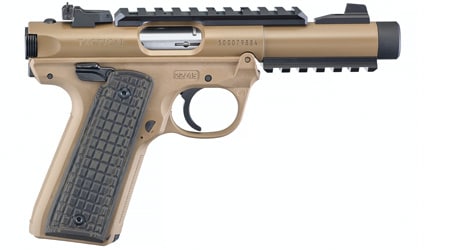
Ruger Mark IV 22/45 Tactical
Midway USA (See Price)
Brownells (See Price)
GrabAGun (See Price)
Cabela’s (See Price)
Scheels (See Price)
KyGunCo (See Price)
BattleHawk Armory (See Price)
Classic Firearms (See Price)
Sportsman’s Outdoor Superstore (See Price)
Hinterland Outfitters (See Price)
Piece of Mind Guns (See Price)
Ruger has owned the rimfire lane for decades, and the Mark-series pistols are a big reason why.
The Mark IV generation kept the classic silhouette but solved the old takedown headache with a simple, one‑button field strip. The 22/45 Tactical variant adds rails and a threaded muzzle, making it a do‑everything .22 that’s equally at home as a suppressor host, plinker, or low‑cost trainer.
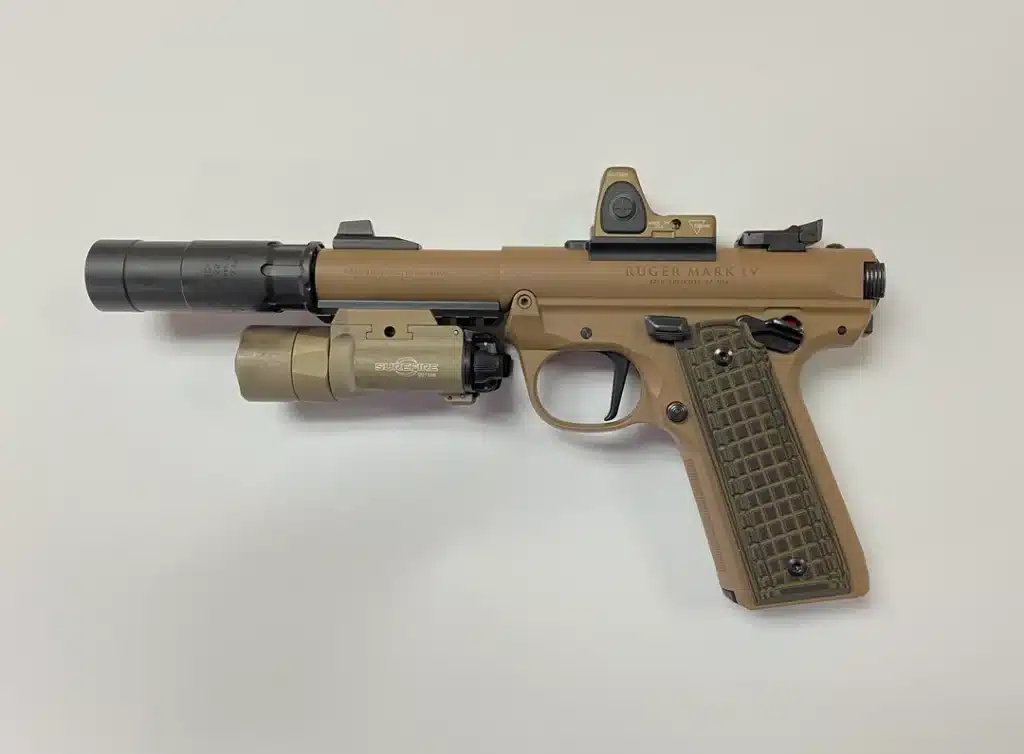
What We Like: The takedown is effortless. It makes cleaning so painless you’ll actually do it. Press, tilt the upper off, and you’re in. Simple.
You get a 1/2×28 threaded 4.40″ barrel (thread protector included) plus top and bottom rails, so a micro red dot up top and a light/laser underneath is plug‑and‑play. This should be standard on most handguns nowadays, but it’s not.
It shoots more accurately than many rimfires because of its fixed-barrel design and Ruger’s quality barrel work, which translates to tight groups on paper and reliable hits on steel. The polymer 22/45 grip frame mimics a 1911’s angle, and the pistol ships with an ambidextrous safety (convertible to left‑side only). Controls are where you expect them, and magazines drop free for quick reloads.
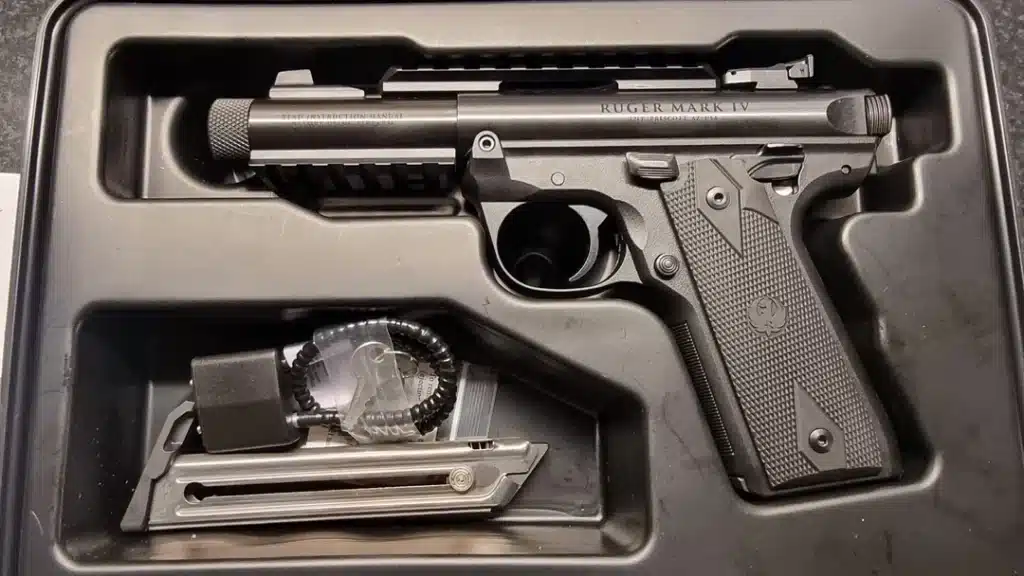
There’s also a huge aftermarket. If you ever want to tune the trigger, swap barrels/uppers, or add competition bits, companies like Tandemkross, Volquartsen, and Tactical Solutions have parts. Think triggers, sight upgrades, barrels, and more.
Flaws but Not Dealbreakers: The trigger out of the box is serviceable but not match grade; expect some initial grit and a pull in the five-pound range that smooths with use or an aftermarket trigger.
The pistol isn’t light, nearly 33 ounces, so it won’t be the best choice if you need something ultra-light, but that weight gives the gun steady tracking and very low perceived recoil.
Standard irons are a bit short if you run a can, so many owners either fit taller sights or just run a dot. It ships with a magazine disconnect that some people like for safety and others dislike for added complexity and a slightly different trigger feel.
Availability can vary, and if you buy used you should check for Ruger’s retrofit history on older Mark pistols before you shoot them.
Bottom Line: If you want a single rimfire pistol that does almost everything well, the Ruger Mark IV 22/45 Tactical is it. Buy it if you value effortless takedown, true accessory flexibility (rails + threads), rock‑solid reliability with the right ammo, and an ocean of upgrades. It’s ideal for new shooters, dot‑curious trainers, and anyone planning to shoot suppressed.
2. BEST CLASSIC TARGET PISTOL: Browning Buck Mark Field Target SR
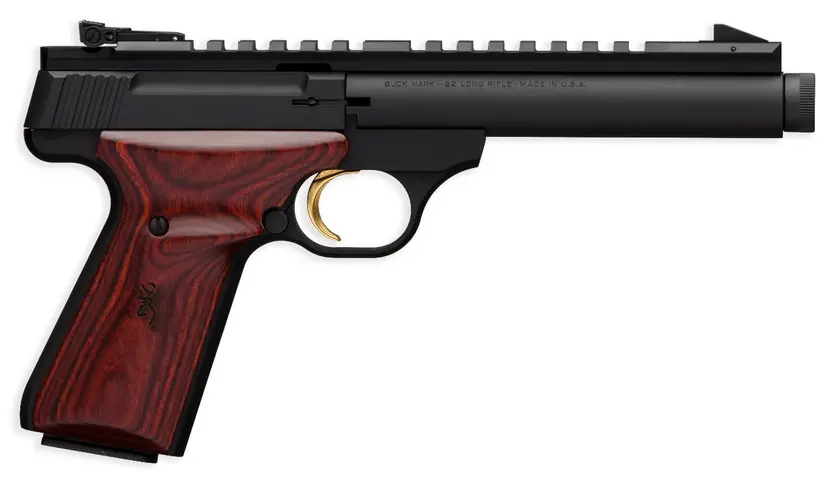
Browning Buck Mark Field Target SR
Cabela’s (See Price)
Sportsman’s Guide (See Price)
Primary Arms (See Price)
Palmetto State Armory (See Price)
Hinterland Outfitters (See Price)
KyGunCo (See Price)
BattleHawk Armory (See Price)
Classic Firearms (See Price)
Browning’s Buck Mark line has been a rimfire staple since the mid‑1980s, and the Field Target SR sits right in the sweet spot for a traditional target pistol that is ready for modern accessories.
You get the classic Buck Mark feel with a heavy bull barrel, adjustable target sights, and a full‑length top rail, plus the “SR” treatment that adds a threaded muzzle for easy suppressor use. It is a heritage design that still checks every box for today’s range days.
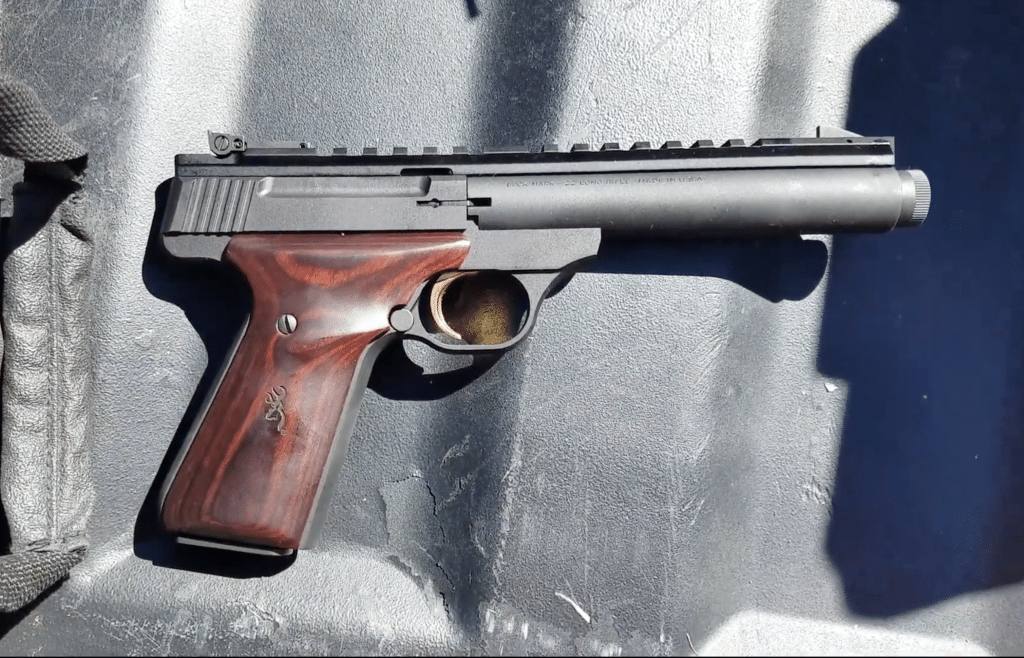
What We Like: The Buck Mark offers real accuracy, not just “.22 is easy.” You’ll get roughly two‑thirds of an inch for 5‑shot groups at 25 yards with match ammo, and the pistol’s trigger breaks crisply at 3 lb 12 oz.
Speaking of the trigger, that gold color is pretty nice.
Hefty bull barrel and steady sight picture. The steel barrel and 38 oz overall weight help the gun sit flat on target, which makes tiny groups feel routine once you settle into a cadence. Sight radius is a generous 8.25 inches.
The sights will actually adjust the way you want. Browning’s Pro‑Target rear sight uses finer 16‑click‑per‑revolution adjustments, and on this model the sights are mounted to the top assembly rather than the reciprocating slide, so your zero does not bounce around.
Additionally, it’s optics and suppressor ready from day one. A full‑length pic rail for adding a dot or scope, and a 1/2×28 threaded muzzle with protector means it is ready for your rimfire can. If you never shoot with a suppressor, you are still getting a target‑grade barrel with a clean crown.
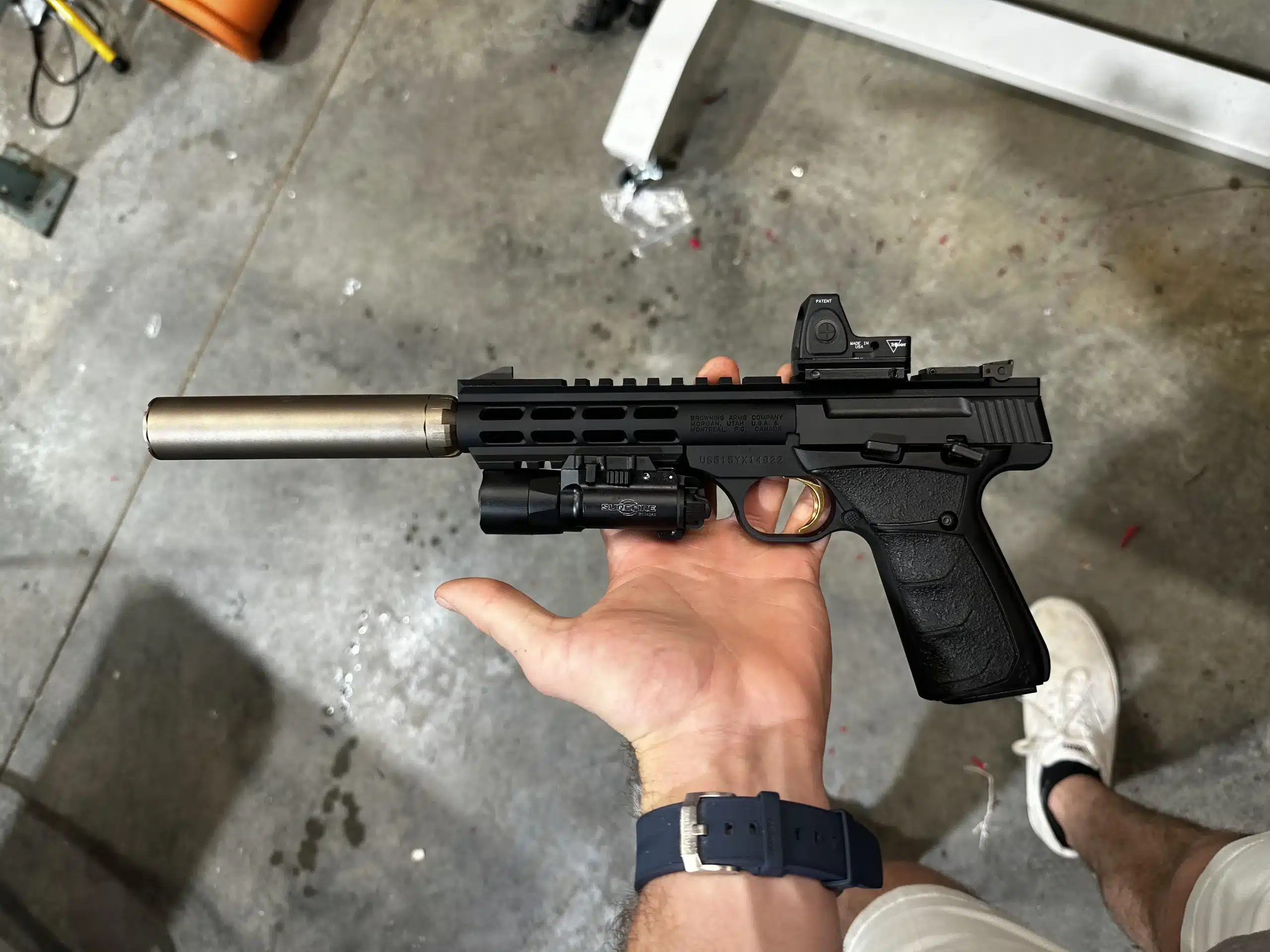
Overall, it has an old‑school feel with some thoughtful details. The laminated cocobolo target grips fill your hand nicely. The single‑action trigger has that Buck Mark crispness, and the 10‑round magazines eject with authority. It feels like a classic because it is one, just updated.
Flaws but Not Dealbreakers: Cleaning takes a little more thought than some rivals. The Buck Mark’s top rail and sight assembly can make full disassembly slower, and Browning recommends routine cleaning from the muzzle with the thread protector in place.
In practice, a quick chamber and breech scrub keeps it running, and you avoid disturbing your zero.
Typical rimfire ammo pickiness can show up. During a 300‑round eval there were a few failures to eject and a couple of dud ignitions. That is par for the course with .22 LR, and most shooters find a load their pistol loves and stick with it.
Another drawback is the right‑handed control layout and magazine disconnect. Southpaws may wish for mirrored controls, and the pistol will not fire without a magazine inserted. Some shooters dislike that, but it is a safety feature and does not affect accuracy or reliability once you get used to it.
Bottom Line: Buy the Browning Buck Mark Field Target SR if you want a traditional, steel‑barreled target pistol that shoots like a laser, takes a red dot without fuss, and is ready to run suppressed. It is ideal for bullseye practice, precision plinking, and training new shooters who will benefit from a steady, soft‑shooting platform.
3. BEST FOR EASY ACCURACY & UPGRADES: S&W SW22 Victory (Target)
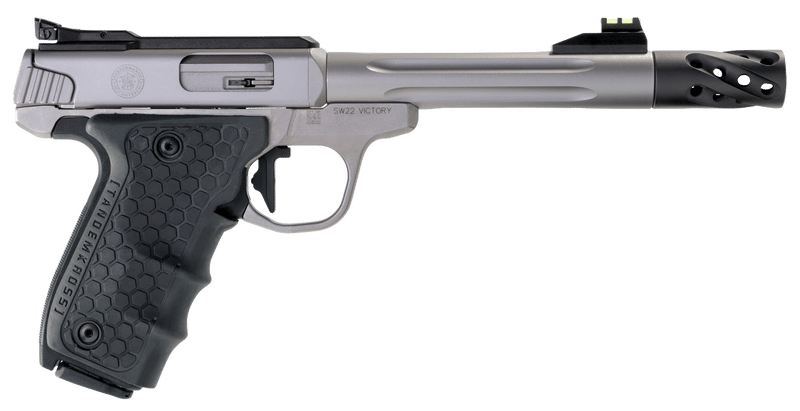
S&W SW22 Victory (Target)
Sportsman’s Warehouse (See Price)
Palmetto State Armory (See Price)
Midway USA (See Price)
KyGunCo (See Price)
Cabela’s (See Price)
Scheels (See Price)
BattleHawk Armory (See Price)
Classic Firearms (See Price)
Hinterland Outfitters (See Price)
Smith & Wesson’s SW22 Victory line was built to make rimfire shooting simple and satisfying. The Target model keeps the platform’s stainless build and easy one‑screw takedown, then adds true target upgrades like a 5.5 inch bull barrel, black target sights, and an included optics rail.
It sits in a sweet spot between classic steel target pistols and modern, modular trainers, with a street price that undercuts many rivals while still feeling premium in hand.
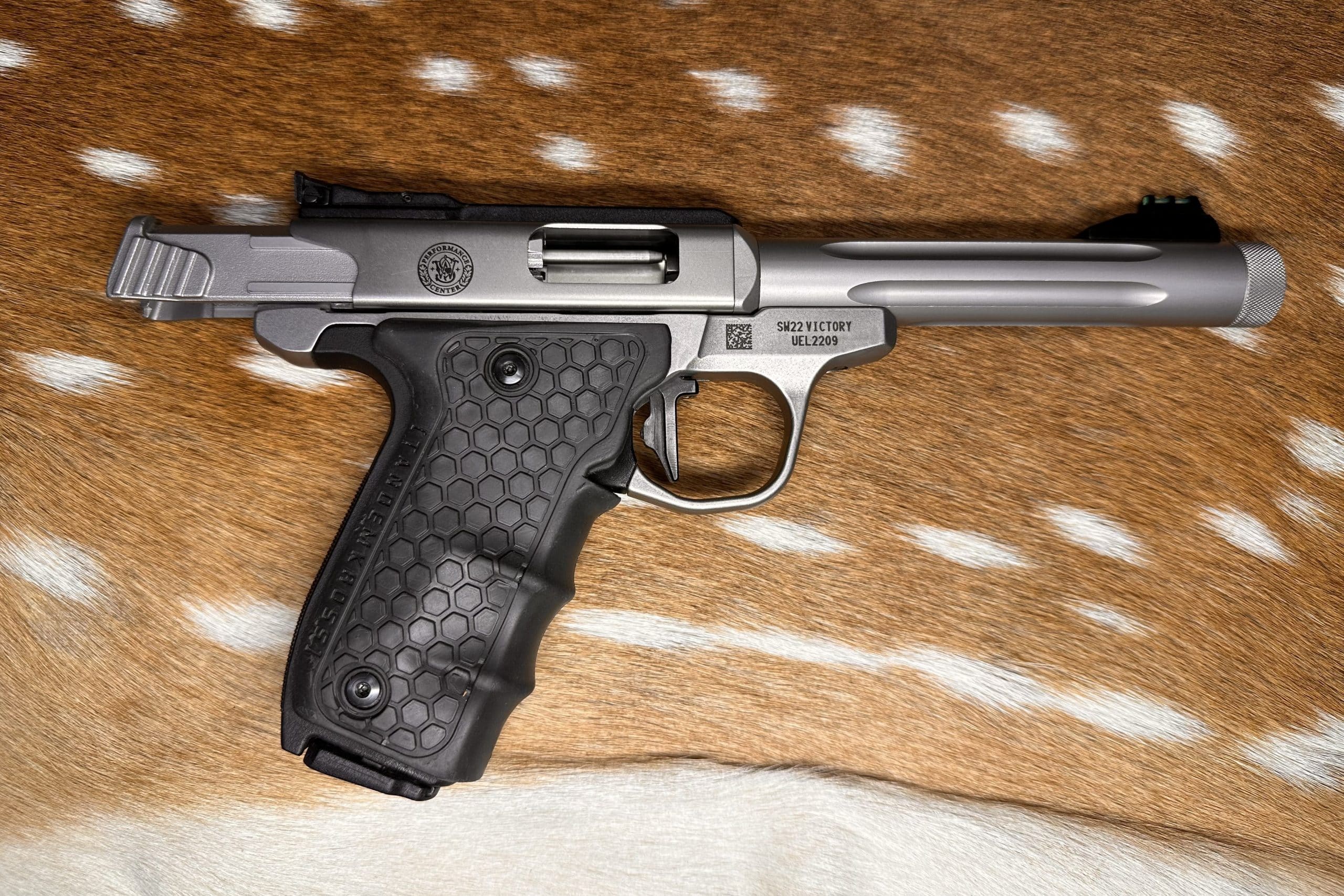
What We Like: Easy accuracy out of the box. The heavy bull barrel and a plain black front with a serrated, fully adjustable rear give a precise sight picture that makes neat little clusters at 25 yards feel routine once you settle your grip. You get a clean, consistent break with an adjustable over‑travel stop.
Fieldstripping is literally one 1/8 inch Allen screw to lift the barrel and upper, then the bolt slides out. Cleaning is fast, and you do not fight tiny pins or contortions.
The gun ships with iron sights installed and a Picatinny top plate in the box. You can swap between irons and dot with minimal shift in point of impact, which is great if you shoot different games on back‑to‑back weekends.
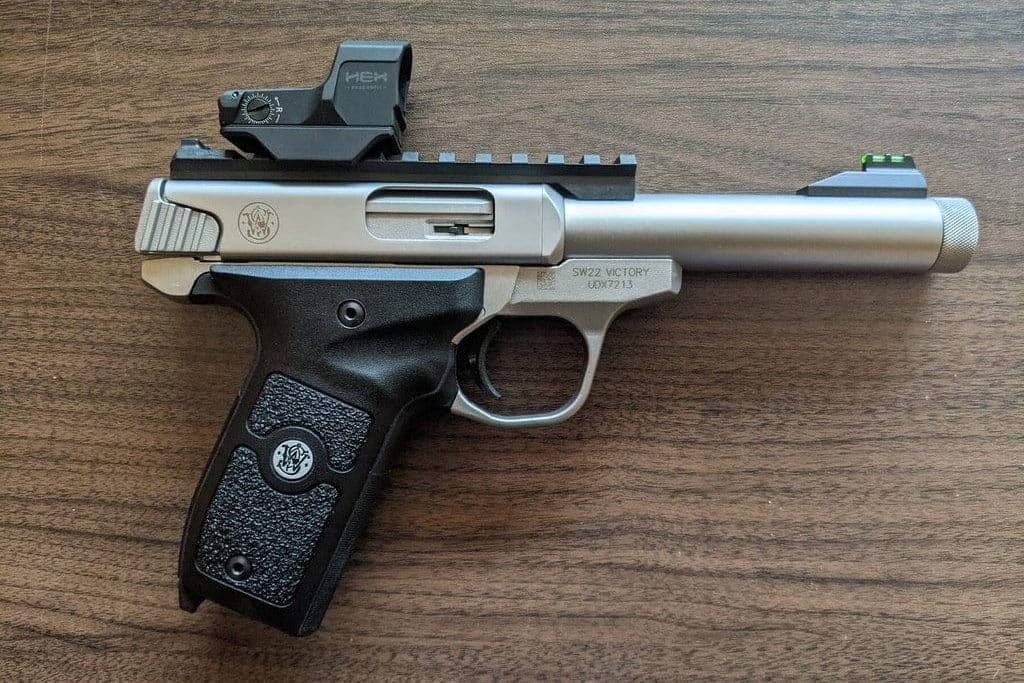
Another positive is the Southpaw friendly grips. The Target model includes right‑ and left‑handed target grip panels with thumb rests, so lefties are not stuck improvising.
There’s also a ton of aftermarket options. If you want a lighter threaded barrel, a different trigger shoe, or small parts that boost reliability, the ecosystem is wide and affordable. Volquartsen and TANDEMKROSS both support the Victory with barrels, extractors, triggers, rails, and more. It is one of the easiest .22 pistols to personalize.
Flaws but Not Dealbreakers: You need a tool to take it apart. The single Allen screw is miles ahead of older multi‑step designs, but it is not the press‑button fieldstrip some competitors offer. Keep the included wrench in your range bag and you are set.
It has a magazine disconnect. From the factory the pistol will not fire without a magazine inserted. Some dislike the feel and extra parts, but it is a safety many owners appreciate, and it does not keep the gun from shooting well.
It is on the heavy side. At about 36 ounces of stainless steel, this is not a featherweight trail gun. The upside is rock‑steady sights, barely any muzzle movement, and a gun that flatters new shooters.
Bottom Line: Buy the SW22 Victory Target if you want a steel .22 that makes tight groups come easy and invites upgrades as your skills grow. It is ideal for bullseye practice, Steel Challenge, rimfire leagues, teaching new shooters, and anyone who wants a simple path to optics and parts.
4. BEST HIGH‑CAPACITY / OPTICS‑READY TRAINER: SIG Sauer P322
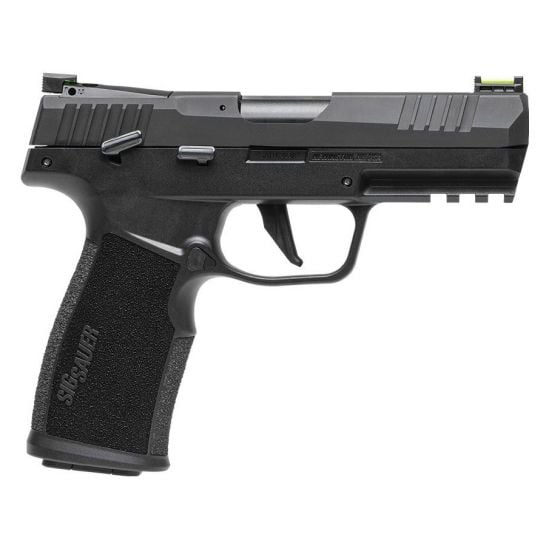
SIG Sauer P322
Midway USA (See Price)
Primary Arms (See Price)
Brownells (See Price)
Cabela’s (See Price)
Scheels (See Price)
KyGunCo (See Price)
BattleHawk Armory (See Price)
Classic Firearms (See Price)
Rainier Arms (See Price)
Sportsman’s Guide (See Price)
Hinterland Outfitters (See Price)
DEGuns (See Price)
SIG’s P322 is SIG Sauer’s modern rimfire trainer that borrows the look and control layout of their centerfire carry pistols, then adds two things most .22 LR handguns skip: true high capacity and out‑of‑the‑box optics readiness.
With 20‑round magazines, an optics‑cut slide, and a threaded‑muzzle adapter in the box, it slots in as a low‑cost practice pistol that still feels like a current defensive gun.
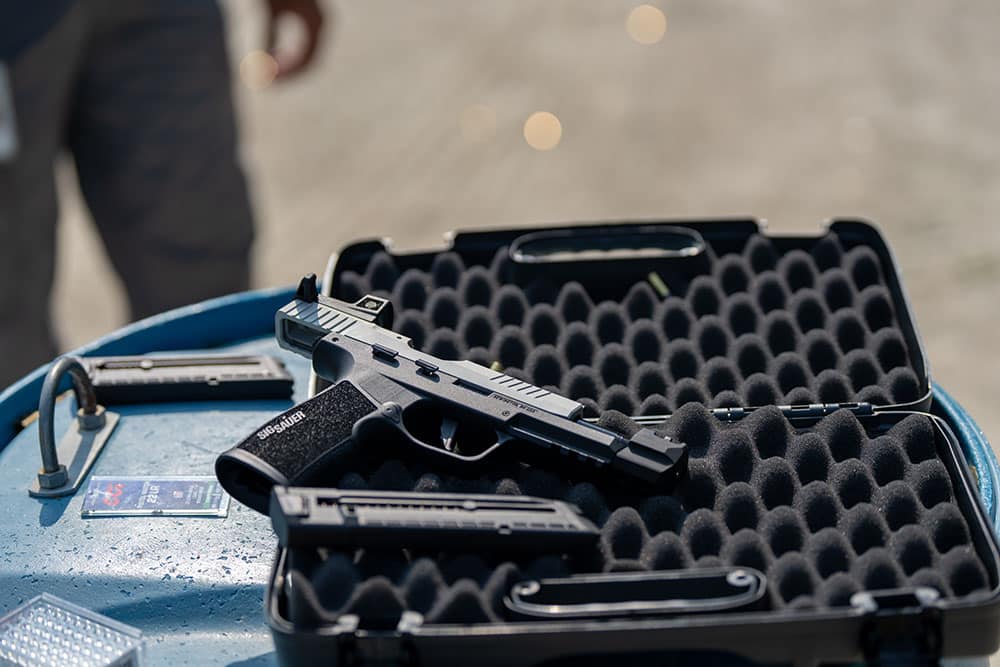
What We Like: You get capacity that makes practice feel endless. Two 20‑round magazines ship with the gun, and SIG now sells 25‑round mags if you want even longer strings. That is class‑leading capacity in a compact rimfire.
We also liked how easy it was to add an optic. Remove the rear‑sight plate and direct‑mount a micro red dot in the ROMEOZero or RMSc footprint. It is a clean install that keeps the dot low and avoids dovetail adapters.
It’s suppressor‑friendly from day one. You get a threaded‑barrel adapter in the box, so running subsonic .22 with a can is plug‑and‑play.
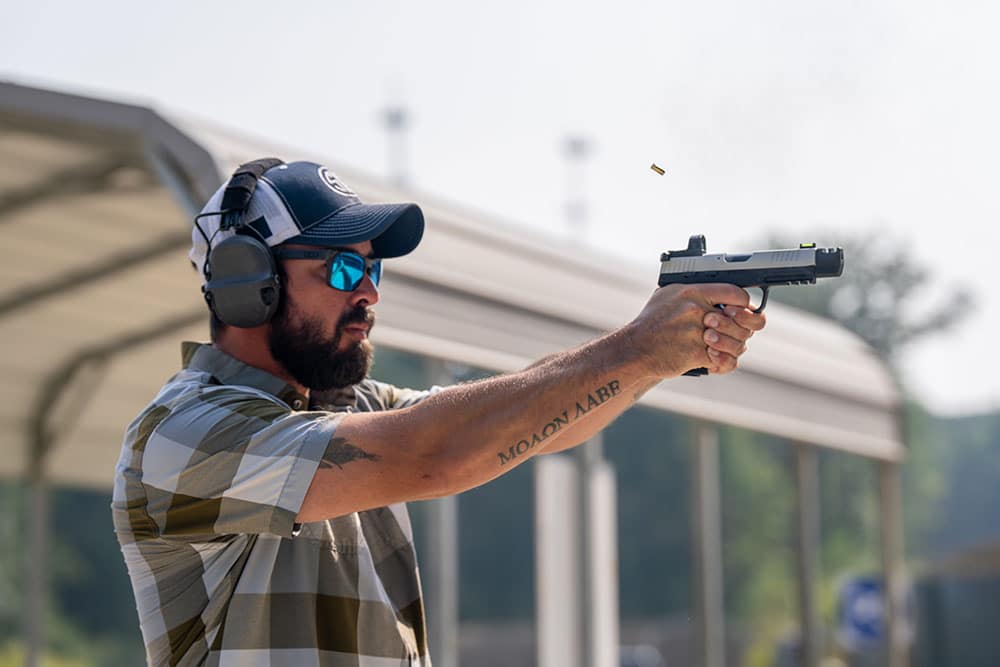
You get ambi controls and smart extras. Manual safety and slide stop are on both sides, the mag release is reversible, and SIG includes both flat and curved trigger shoes so you can pick the feel you prefer.
Additionally, we liked the easy fieldstrip and forgiving trigger weight. Just rotate the takedown lever and the slide lifts off without pulling the trigger. The trigger has a light single‑action pull thanks to the P322’s internal hammer layout.
With the right ammo, you can get tidy groups at typical training distances, including sub‑inch clusters from a rest at 25 yards. For a compact trainer, that is plenty to reinforce fundamentals under a red dot.
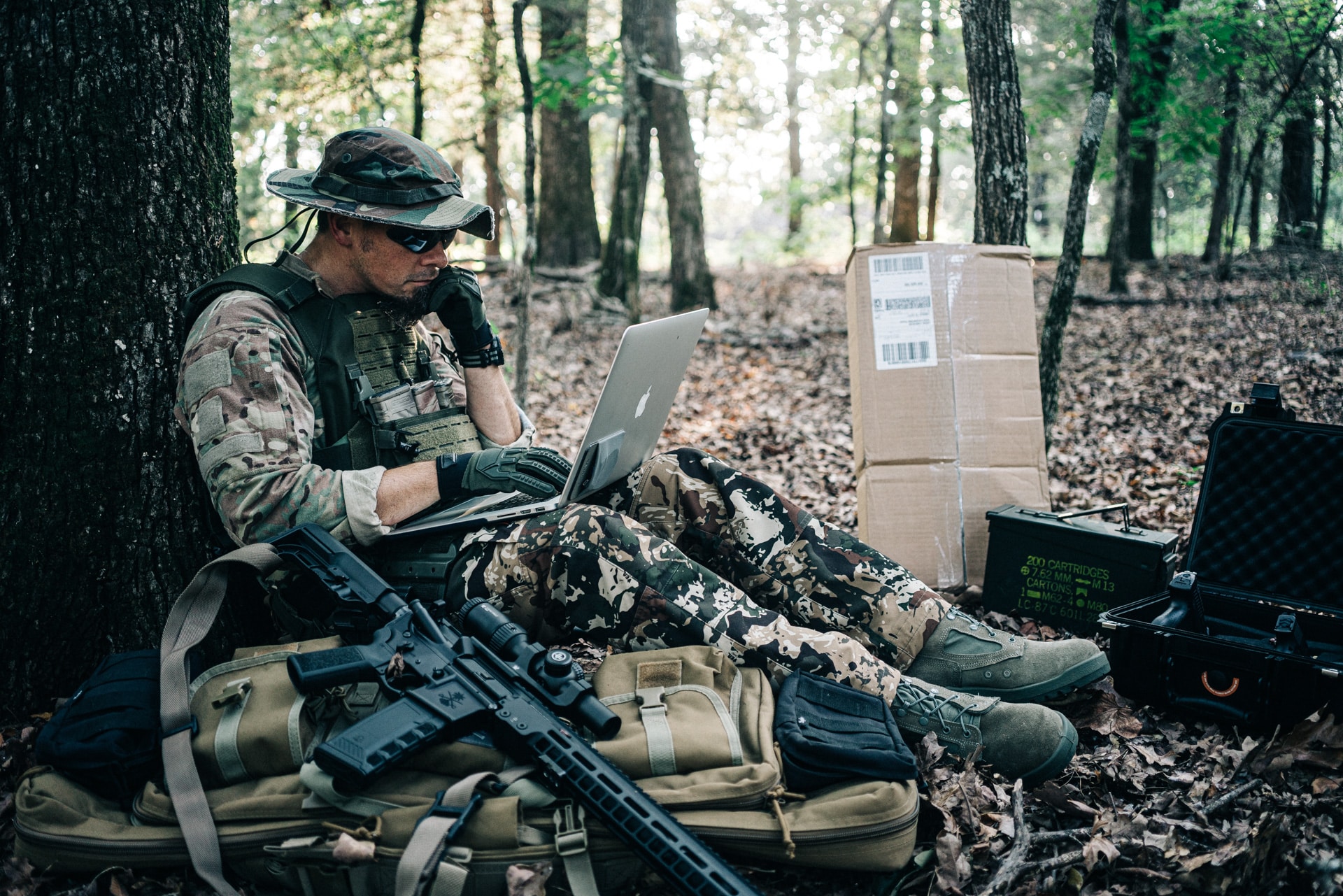
More from CAT Outdoors:
Daily Deals
Best 9mm Carbines
Best 10mm Handguns
Best 1911 Guns
Best AR-15s
Flaws but Not Dealbreakers: Trigger feel is more spongy than crisp. It shoots fine, but if you are chasing a glass‑rod break you might notice some springy take‑up. The upside is the weight is friendly for newer shooters, and aftermarket shoes exist if you care to tinker later.
Reports from 2022 into 2023 mentioned light strikes, barrel leading, and occasional slide‑lock quirks. Later experiences have been more positive, and many issues turn out to be magazine loading or ammo related, which is common across rimfire pistols.
If you stack rounds evenly in the mags and stay with quality plated ammo, you should get a smooth firing experience.
Lastly, the footprint is RMSc sized. That is the most common micro‑dot pattern now, but if you run something oddball you may need an adapter. SIG’s own ROMEOZero Elite uses that same pattern and drops right on.
Bottom Line: Buy the P322 if you want a modern trainer that mirrors the feel of today’s carry pistols, feeds you long 20‑plus‑round strings, and makes it easy to add a dot and a suppressor without extra parts. It shines for high‑repetition drills, new‑shooter coaching, and anyone who wants centerfire‑style reps at rimfire cost.
5. BEST VALUE OPTICS‑READY TRAINER: Taurus TX22 TORO
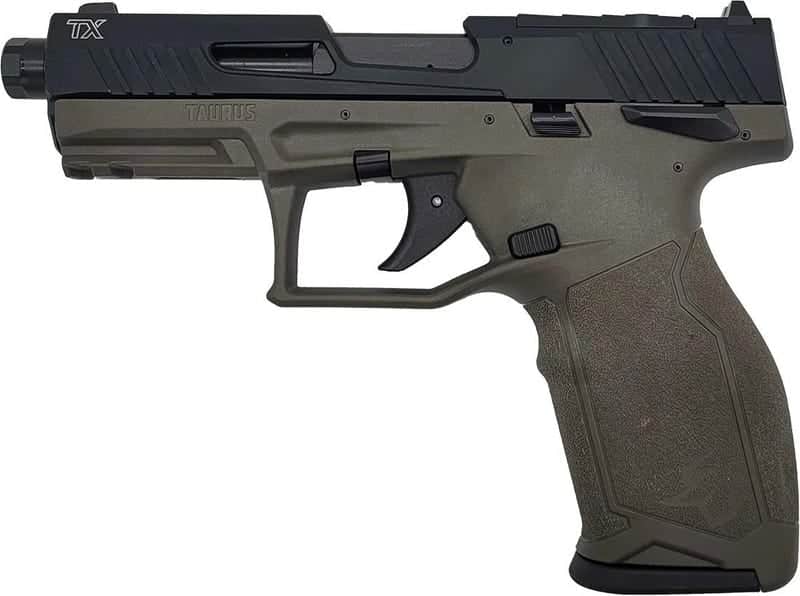
Taurus TX22 TORO
Primary Arms (See Price)
KyGunCo (See Price)
BattleHawk Armory (See Price)
Classic Firearms (See Price)
Hinterland Outfitters (See Price)
DEGuns (See Price)
Piece of Mind Guns (See Price)
Taurus built its recent reputation on value, and the TX22 series is the clearest example.
The TX22 TORO (Taurus Optic Ready Option) takes the already popular full‑size rimfire and adds an RMSc‑pattern slide cut for micro red dots, a threaded barrel, and higher‑capacity magazines without pushing the price out of reach. It lands squarely as a budget‑friendly, modern trainer that still feels feature‑rich.
What We Like: Firstly, the price to value ratio. The TORO’s MSRP sits well under many competitors while still including the optic cut, threaded barrel, and rail. That is rare at this feature level.
The pistol is optics ready without gymnastics. The slide is cut for the popular Shield RMSc footprint, so mounting a micro‑dot is straightforward and widely supported. That makes it easy to mirror your carry setup on cheap .22 LR.
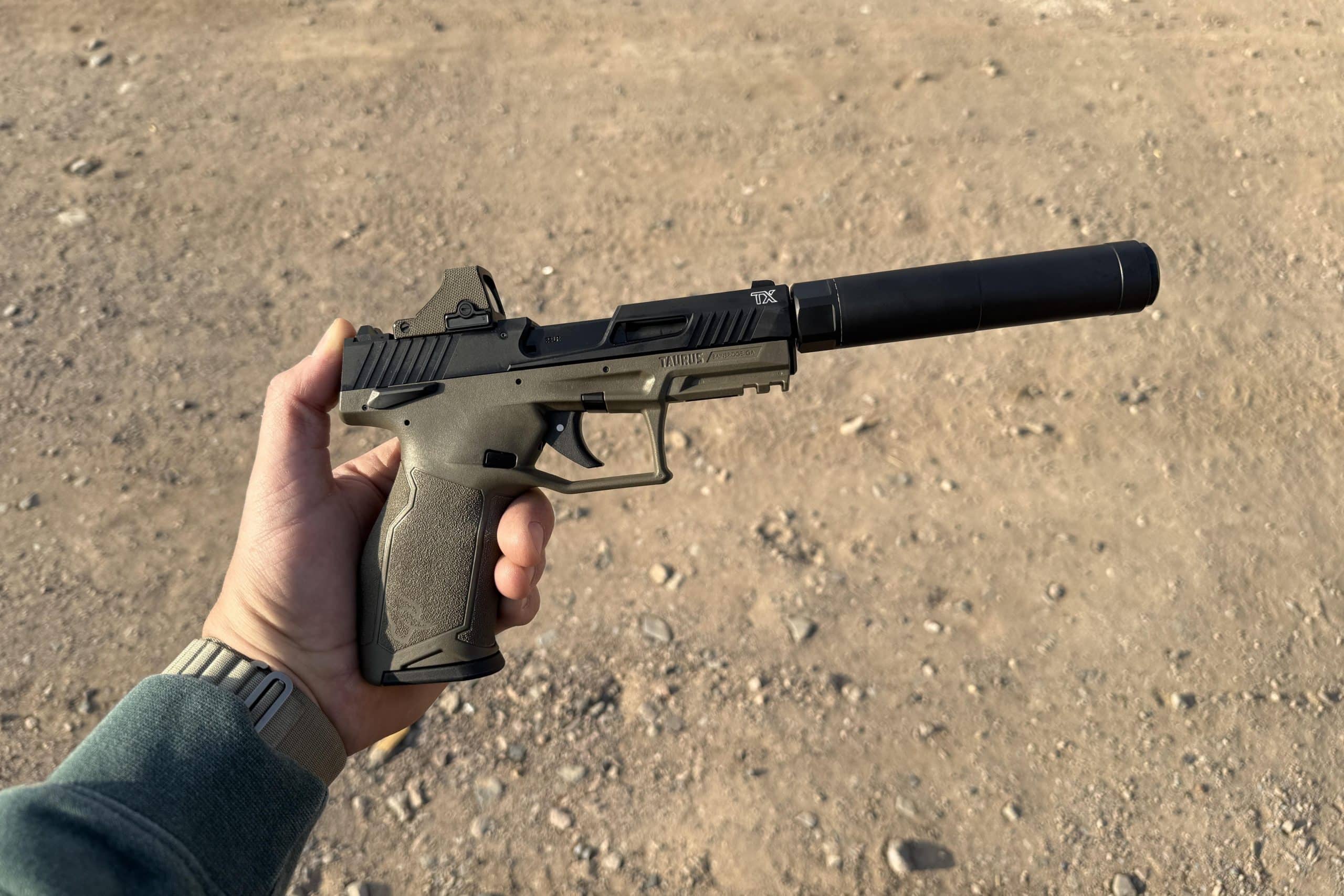
Additionally, current TORO packages include two magazines and support the new 22‑round format, with some SKUs bundling a 16‑rounder as well. Fewer reloads means more time practicing strings and transitions.
The TORO’s heavy barrel is threaded 1/2×28, so adding a rimfire can or comp is as simple as spinning it on. No older collar needed on this version. Also, the fundamentals feel right. Taurus’ Performance Trigger System and a full‑size grip make the gun easy to shoot well for new and experienced shooters alike. Weight and dimensions stay light enough for long sessions.
The aftermarket support is strong if you want brighter irons, extended base pads, or other tweaks. TANDEMKROSS and Lakeline sell fiber‑optic sights, +5 magazine extensions, and more.
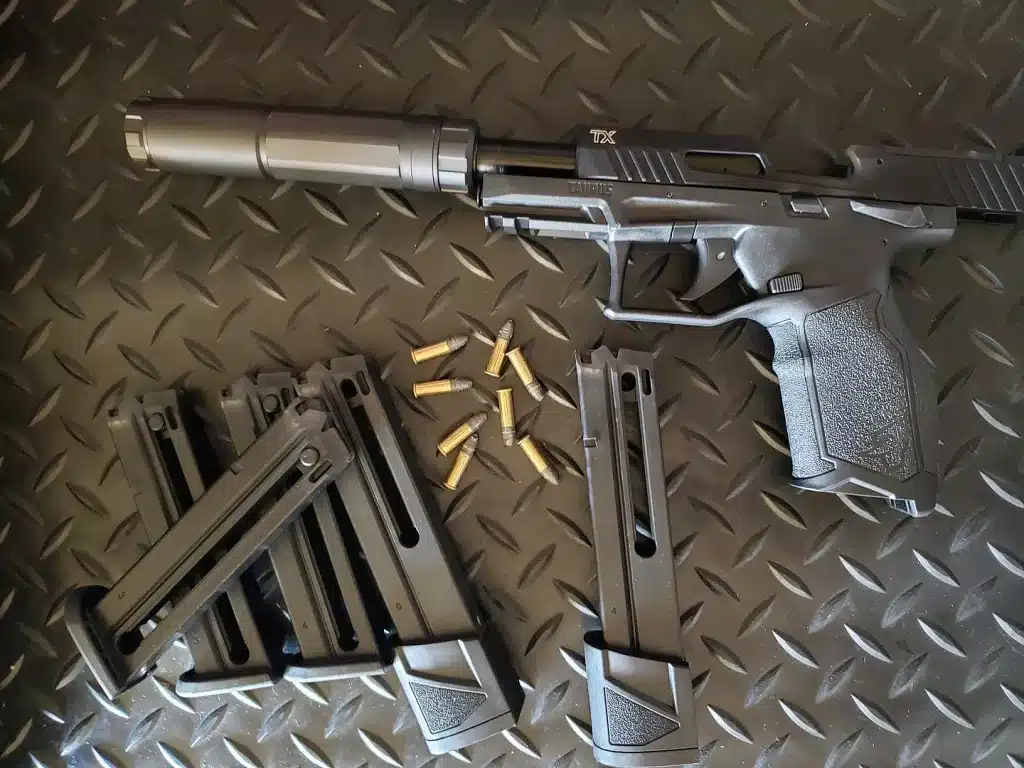
Most importantly, it runs. You get excellent reliability across mixed ammo, including subsonic and high‑velocity loads, which is exactly what you want in a high‑repetition trainer.
Flaws but Not Dealbreakers: Plastic, drift‑only rear sight. Out of the box you get a fixed front and drift‑adjustable rear, which works fine for plinking but is less flexible than a fully adjustable target sight. Many owners swap to brighter aftermarket irons if they plan to shoot irons a lot.
The 22‑round magazine loads stiffer. The extended mag lacks the easy pull‑down follower found on the 16‑rounders, so topping off takes a bit more thumb work until it breaks in. A loader helps.
Expect the usual rimfire maintenance, especially when suppressed. Like most .22s, running a can increases blowback and fouling, so plan on cleaning a bit more often to keep it at peak reliability.
Co‑witness isn’t the point here. With a low micro‑dot and the stock irons, you should not expect a usable co‑witness. Most trainers won’t miss it, but if you live on irons, consider an aftermarket sight upgrade.
Bottom Line: Buy the Taurus TX22 TORO if you want an affordable, optics‑ready .22 that lets you practice with a red dot, run a suppressor, and shoot long strings on a budget. It shines for high‑volume drills, new‑shooter coaching, and anyone who wants a modern control layout with rimfire economics.
6. BEST OPTICS & SUPPRESSOR‑READY OUT OF THE BOX: FN 502 Tactical
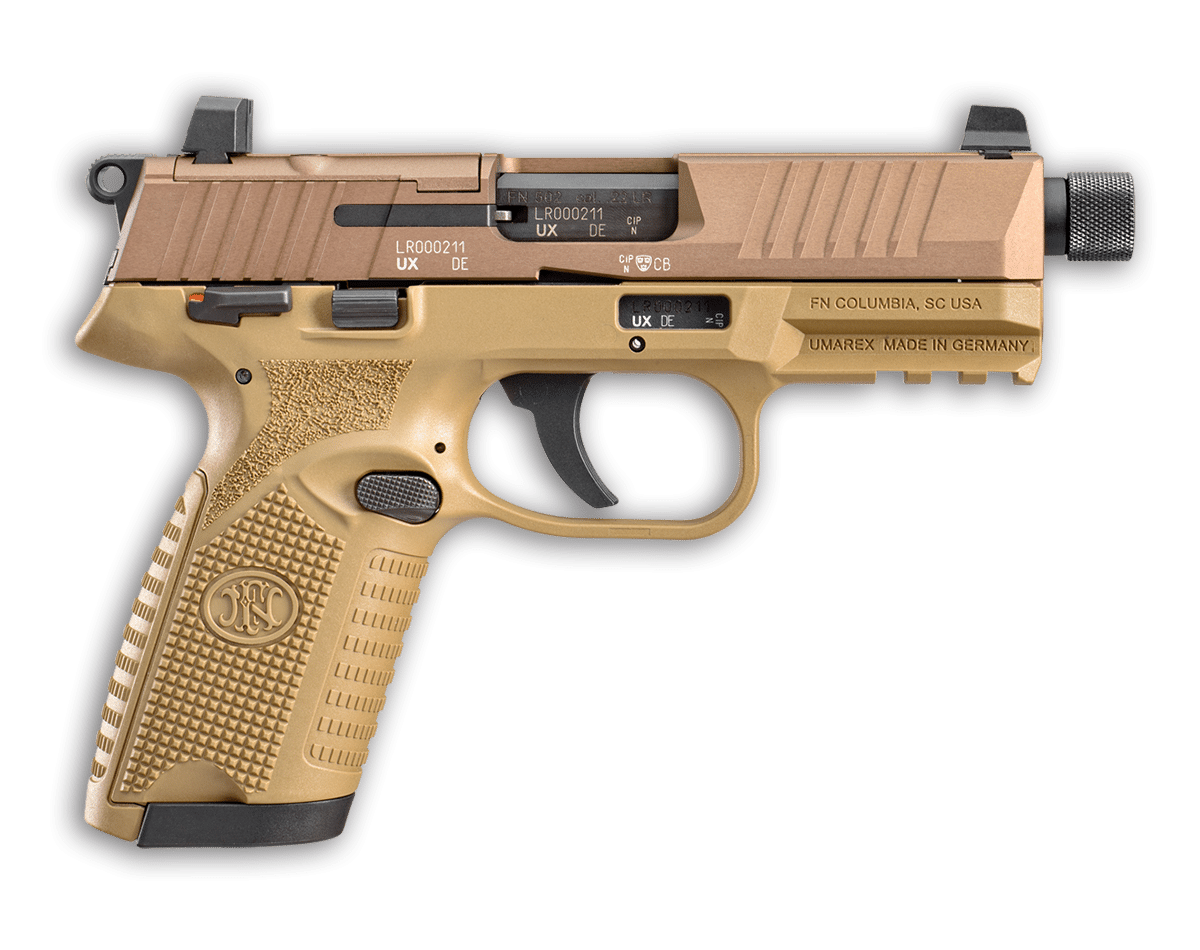
FN 502 Tactical
GrabAGun (See Price)
Midway USA (See Price)
Primary Arms (See Price)
KyGunCo (See Price)
BattleHawk Armory (See Price)
Classic Firearms (See Price)
Hinterland Outfitters (See Price)
DEGuns (See Price)
FN built the 502 Tactical to feel like its 509 duty pistol in a cheap‑to‑feed rimfire format. It was also the first .22 LR to ship with a slide cut and plate system for mounting a red dot, which set the tone for the modern optics‑ready rimfire class.
You get a threaded 4.6 inch barrel, suppressor‑height sights, and ambidextrous controls in a 23.7 oz package that mirrors a centerfire trainer. Street price typically hovers around $460.
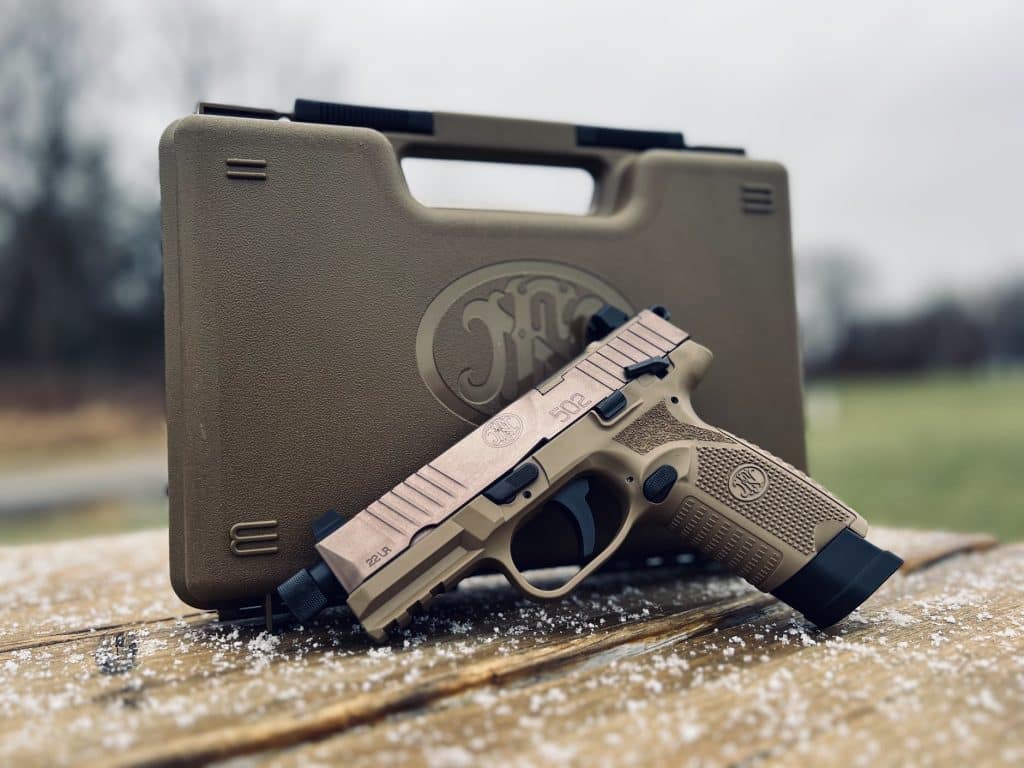
What We Like: The 502 is ready for a dot and a can on day one. The slide comes optics ready and the pistol includes plates for common footprints like Trijicon RMR, Shield RMS and Docter. Plates have an integral tall rear sight to co‑witness with the factory front. The barrel is threaded 1/2×28 with a protector, so most rimfire suppressors spin right on without an adapter.
In your hands, it feels like a centerfire service gun. The grip texture and control layout track closely with the 509 family, and FN even notes the 502 fits most 509 Tactical holsters. That makes it a natural understudy for defensive‑pistol practice at rimfire cost.
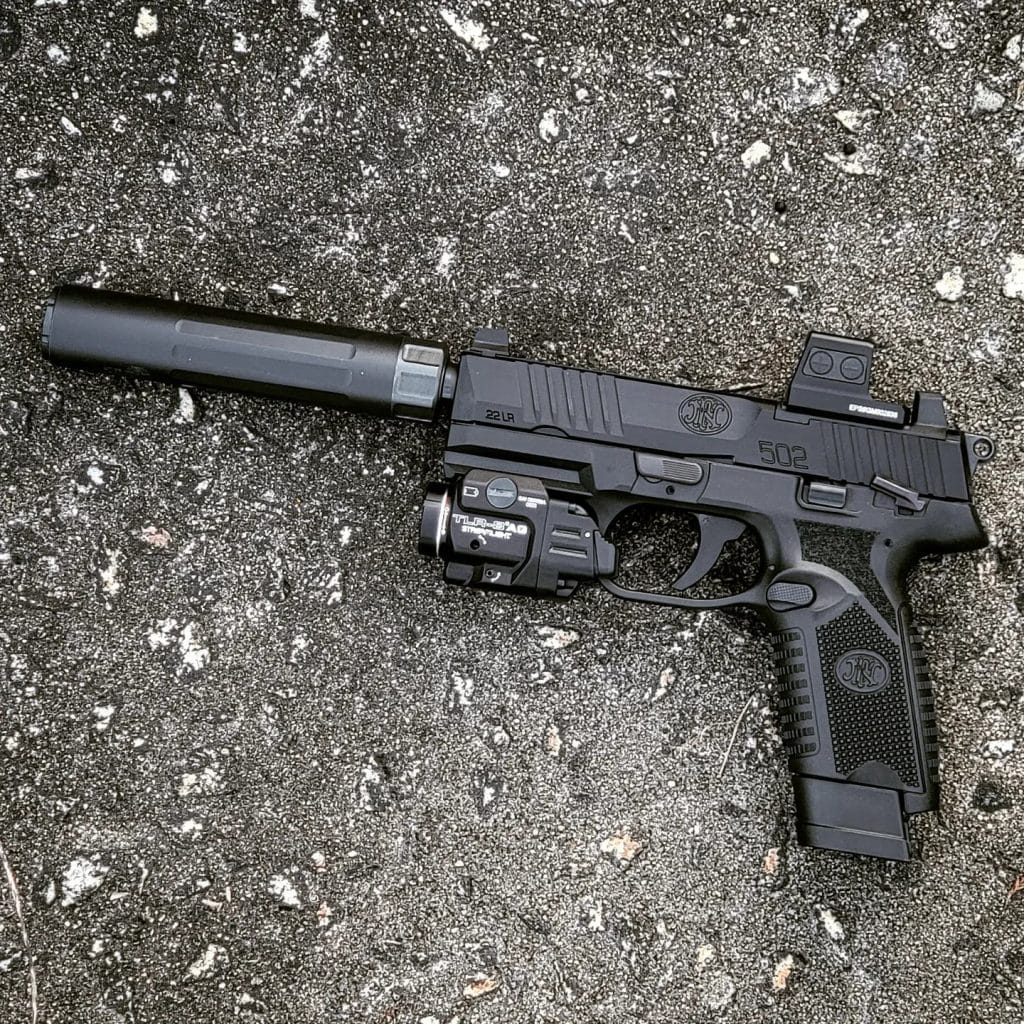
Safety, slide stop and mag release are bilateral or reversible, which is rare at this price.
Easy fieldstrip and forgiving trigger. Lock the slide, rotate the takedown lever, and the top end comes off without tools or pulling the trigger. The single‑action unit is light for a rimfire trainer, which helps new shooters call shots under a dot.
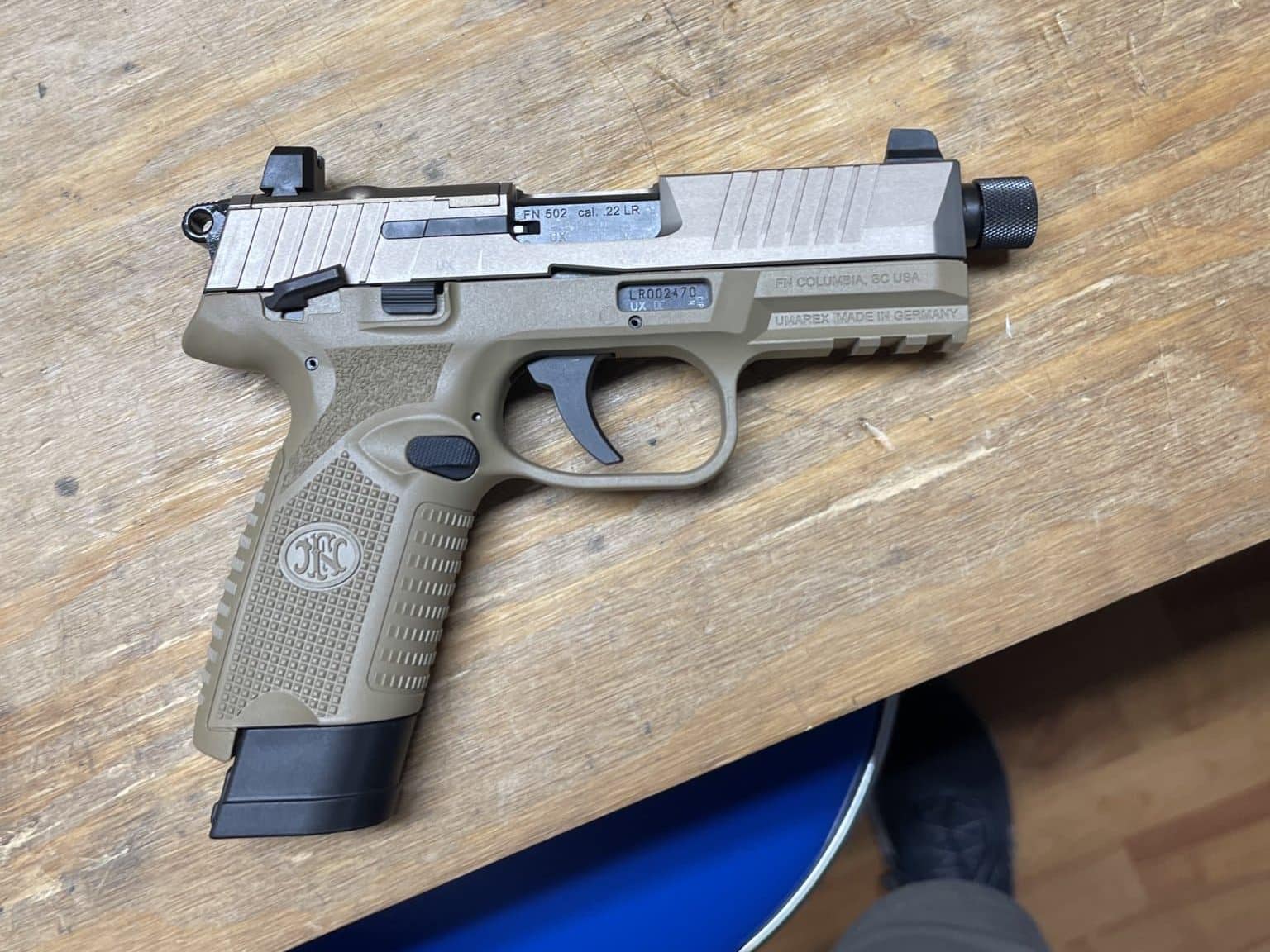
Lastly, we also like that you get suppressor‑height irons out of the box. You do not have to chase taller sights to see over a can, and the sight picture lines up with most micro dots when mounted on the included plates.
Flaws but Not Dealbreakers: Some parts are polymer, including the factory sights and the included optic plates. They work, but steel or aluminum would be sturdier for hard use. If you plan to pound lots of rounds, consider upgrading plates later.
Trigger feel is light but not match‑crisp. You get a touch of spongy creep and a longer reset than expected. It shoots well for training, and most owners run a dot anyway, which makes the break less noticeable.
Typical rimfire ammo sensitivity can show up, especially before a good cleaning. In our testing, a few failures early on disappeared after cleaning the ejector and running quality ammo. That is common with blowback .22s.
Optic footprints beyond the included plates may require aftermarket adapters. For example, Holosun K‑pattern dots need a dedicated plate. The good news is that several companies sell solid adapters sized for the 502.
An important note if you are buying used, check the 2022 safety recall. Early pistols could fire with the safety engaged if an internal lever was missing or mis‑installed. FN’s site lets you verify and arrange the free fix.
Bottom Line: Get the FN 502 Tactical if you want a rimfire that is truly optics‑ and suppressor‑ready right out of the box. It is ideal for centerfire‑style practice, high‑rep dot work, and coaching new shooters with minimal blast.
7. BEST TRAINER FOR GLOCK OWNERS: Glock 44
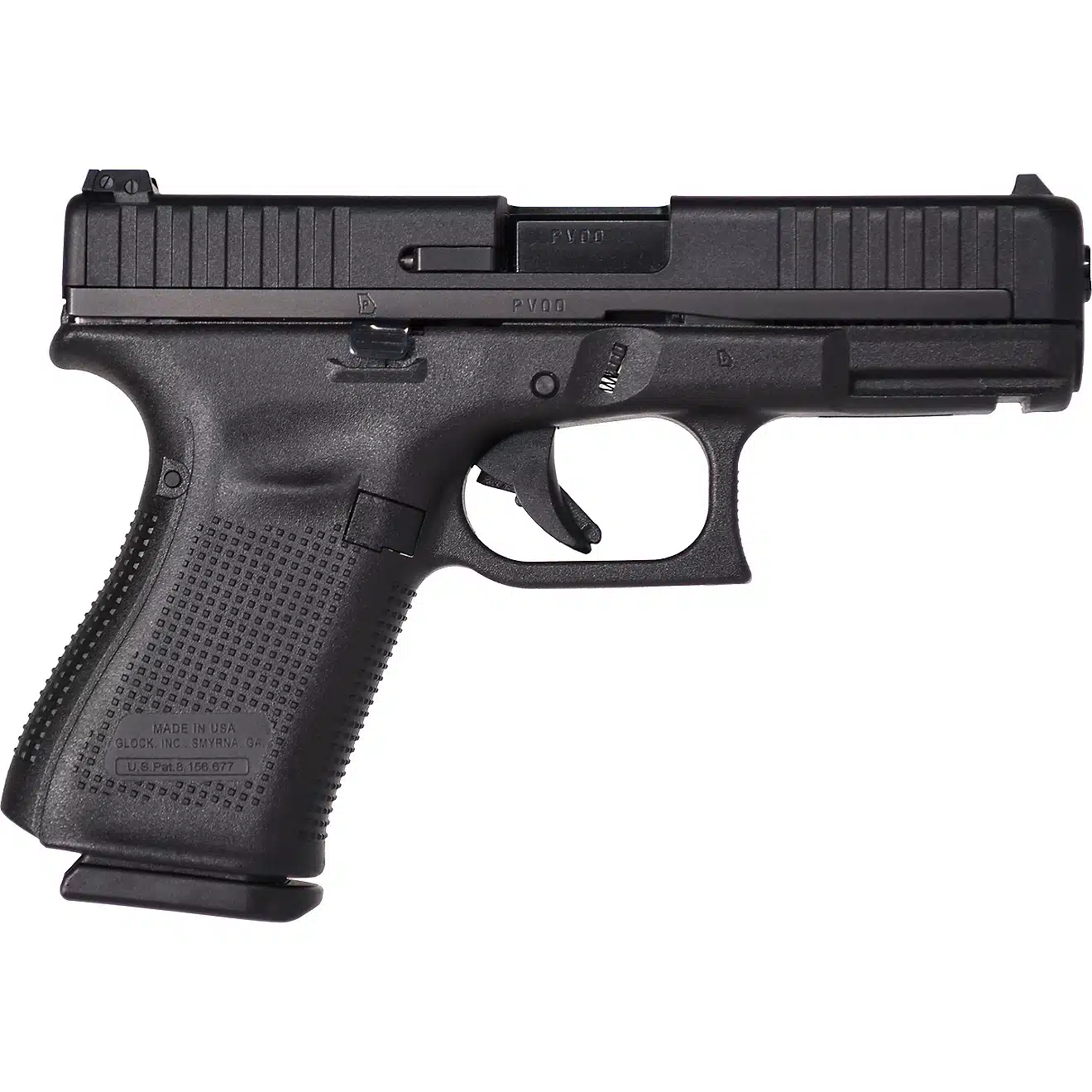
Glock 44
Sportsman’s Guide (See Price)
Guns.com (See Price)
Classic Firearms (See Price)
Midway USA (See Price)
KyGunCo (See Price)
Hinterland Outfitters (See Price)
Brownells (See Price)
BattleHawk Armory (See Price)
The Glock G44 is a rimfire stand‑in for the company’s most popular carry gun, the G19. Same general size and controls, far cheaper ammo, and very little recoil, which makes it a natural bridge between dry‑fire practice and live‑fire reps.
It launched in 2019 as Glock’s first .22 LR pistol, with adjustable rear sights, the GLOCK Marksman Barrel, and 10‑round load‑assist magazines. If you already live in the Glock ecosystem, the G44 drops right into your routine.
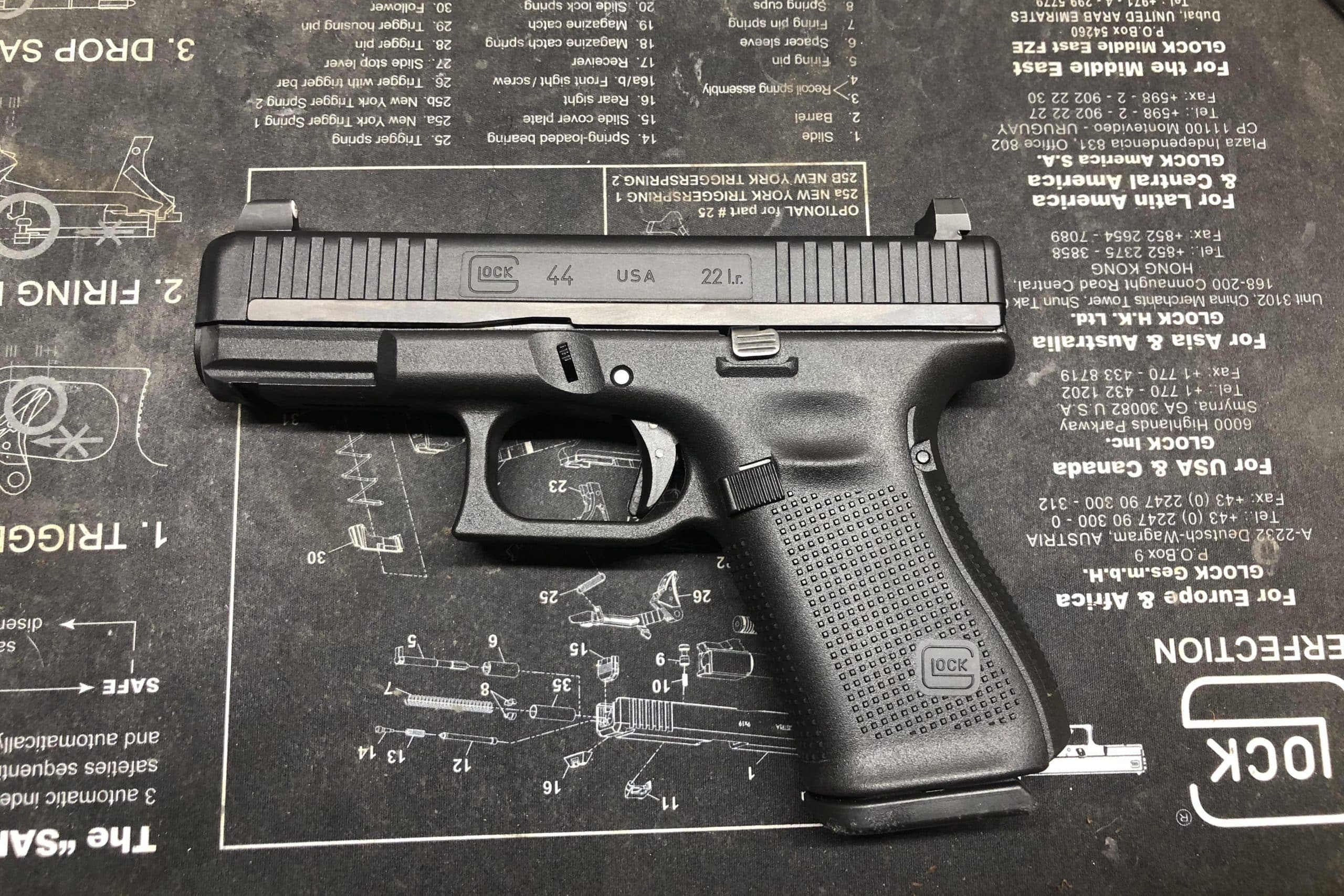
What We Like: Familiar feel and controls that transfer skills. The G44 mirrors a Gen 5 G19 in size and trigger feel, so your grip, presentation, reloads, and sight picture all translate to your centerfire gun. That is the whole point of a trainer, and it works.
The G44 will fit a lot of your existing gear, i.e. most G19 holsters and magazine pouches, which keeps your practice setup simple.
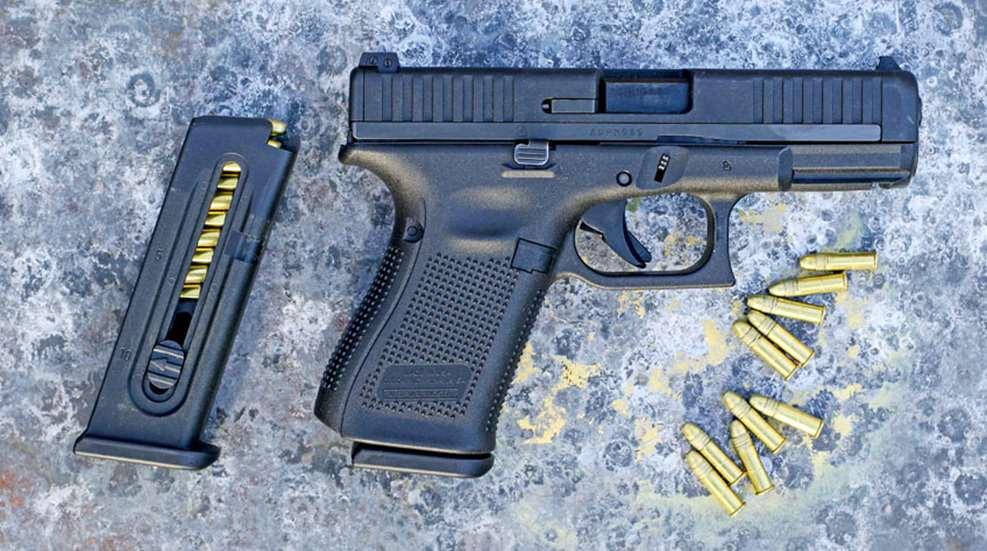
At roughly 14.6 ounces with an empty mag and a 4.02 inch barrel, recoil is minimal. The pistol ships with adjustable rear sights, interchangeable backstraps, and two magazines with load‑assist tabs that make topping off painless.
The accuracy is terrific for a trainer handgun. We averaged 2.78 inch, 5‑shot groups at 15 yards and found the gun most reliable with hotter .22 loads like CCI Blazer. For reinforcing fundamentals under time, that is plenty.
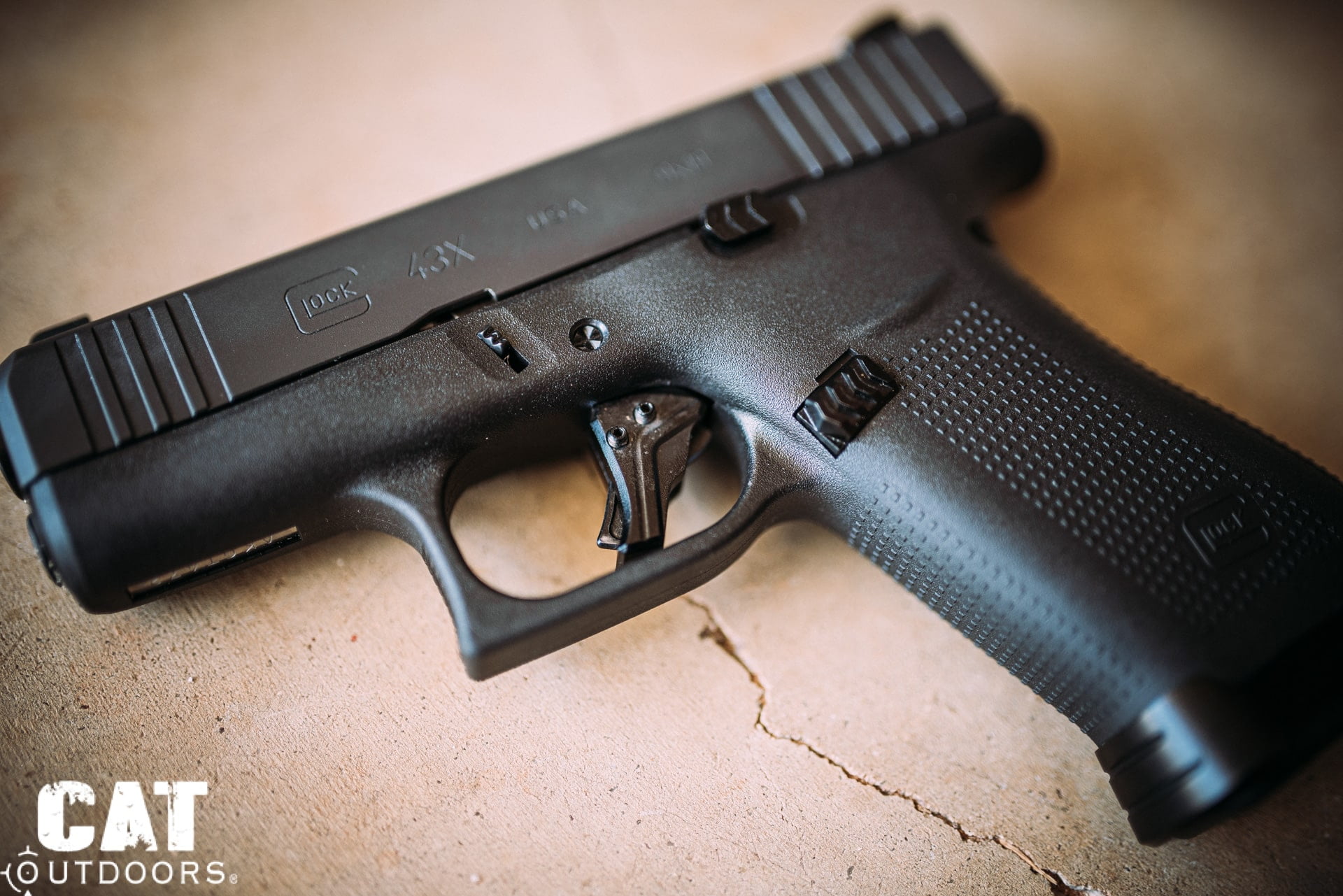
More for Glock Owners:
Best Glock Handguns
Best Glock Triggers
Best Glock Sights
Best Glock Holsters
The threaded‑barrel path is straightforward. Glock sells an OEM threaded barrel kit for the G44 that includes an M9x0.75 barrel and a 1/2×28 adapter, so adding a rimfire suppressor later is simple.
Flaws but Not Dealbreakers: The first thing we notice is it’s not optics ready from the factory. There is no MOS slide here. If you want a dot on a G44, you will need a dovetail mount or an aftermarket aluminum slide that accepts micro optics. The latter is the cleaner solution if a dot is a must.
Another downside is the capacity is only 10 with OEM mags, though third‑party 18 and 25‑round magazines do exist.
Not every duty holster fits perfectly. Most G19 holsters are fine, but a few retention models with muzzle posts need tweaks. Try before you buy if you run a specific duty rig.
Lastly, there were some issues early on with the slide. There were reports of cracked or broken parts when the pistol first hit the market, but independent durability testing past 2,000 rounds found no slide problems on the sample gun. Keep your pistol clean and fed decent ammo, and you should be alright.
Bottom Line: If you own a Glock and want a rimfire that mimics your carry pistol’s size, trigger feel, and manual of arms, the G44 is the easy button. It shines for high‑rep fundamentals, economical live‑fire between dry‑fire sessions, and introducing new shooters without changing ergonomics.
8. BEST COMPACT DA/SA .22 PISTOL: Ruger SR22
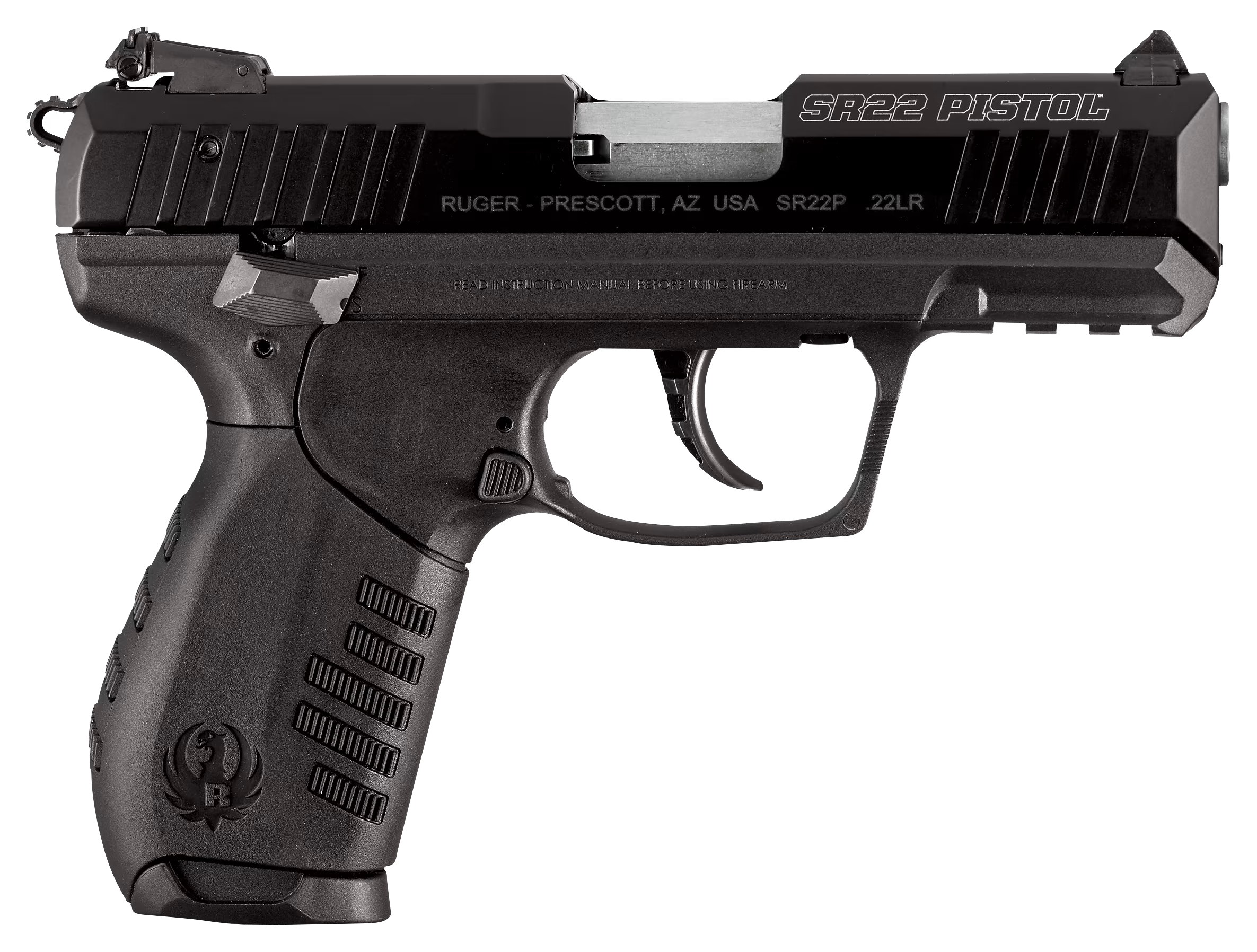
Ruger SR22
Cabela’s (See Price)
Guns.com (See Price)
Primary Arms (See Price)
Classic Firearms (See Price)
Midway USA (See Price)
Hinterland Outfitters (See Price)
Scheels (See Price)
BattleHawk Armory (See Price)
DEGuns (See Price)
Ruger’s SR22 is a compact, hammer‑fired rimfire built to be simple, light, and friendly for a wide range of shooters. It pairs a polymer frame with an aluminum slide and a true double‑action/single‑action system, giving you a decocker‑equipped trainer in a very manageable size.
The standard model wears a 3.5 inch barrel and adjustable sights, while a 4.5 inch variant adds sight radius without changing the basic formula. In a market full of striker‑style .22s, the SR22 stands out as the easy, small DA/SA option.
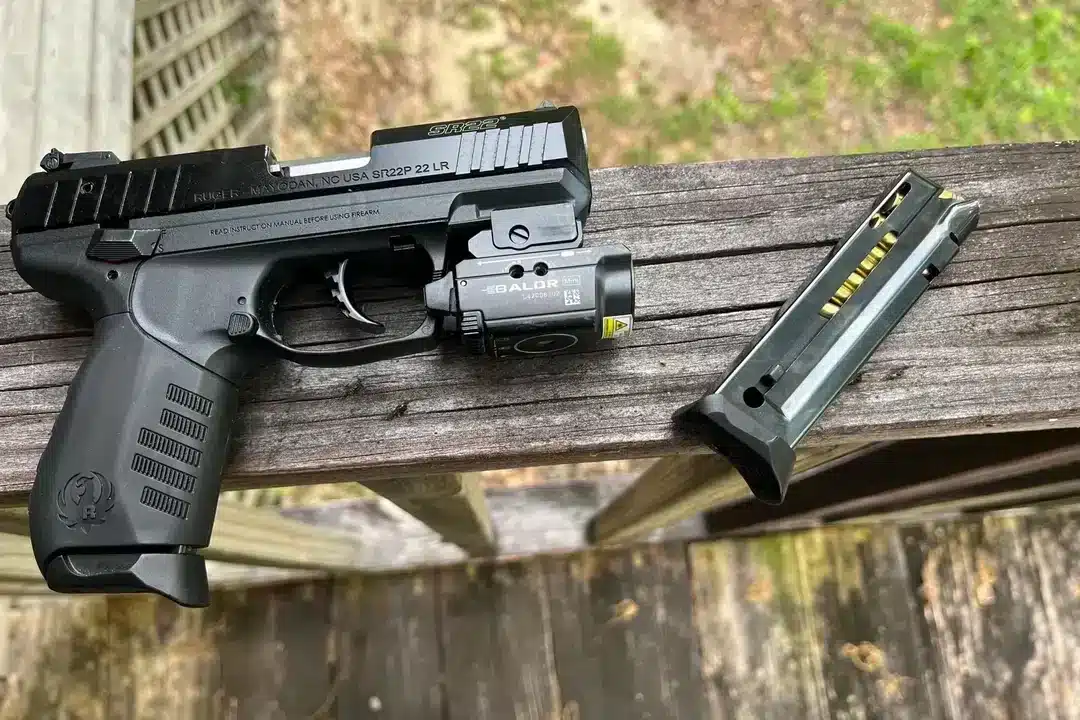
What We Like: The ambidextrous lever works as both safety and decocker, and the mag release is ambi too. It’s exactly the manual of arms you want if you run DA/SA centerfire pistols.
Surprisingly, you get complete sights for a small pistol. You get a 3‑dot set with a fixed front and a rear that adjusts for windage and elevation; the rear blade is reversible if you prefer a plain black notch. That’s a lot of tuning for a compact rimfire.
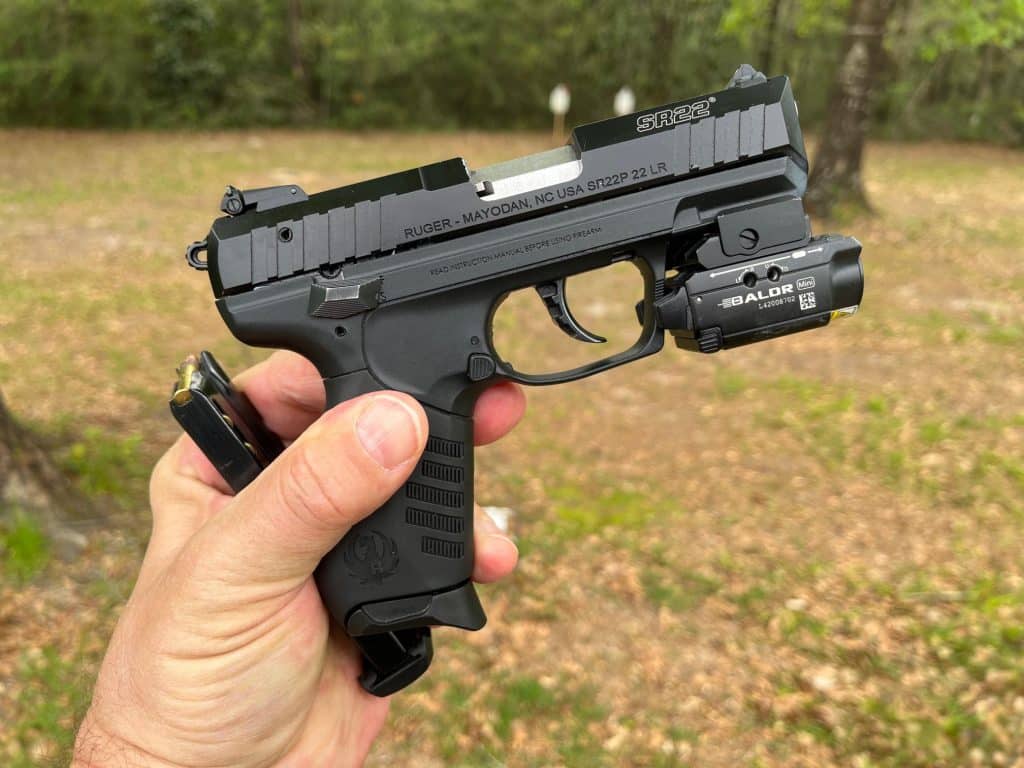
Fieldstripping is easy and dry practice is stress free. Flip the takedown lever and the slide lifts off; no tiny pins or tools. Ruger’s manual also approves dry firing as long as a magazine is inserted, which makes at‑home DA reps simple.
As far as the feel goes, it was lightweight with some small‑hand‑friendly ergonomics. At about 17.5 ounces with the 3.5 inch barrel, the SR22 ships with two interchangeable rubberized grip sleeves and two finger‑rest baseplates so you can tailor the feel.
The SR22 is also ready for lights and, if you want, a can. There’s a Pic rail under the dustcover for a compact light or laser, and the threaded‑barrel model includes the 1/2×28 adapter and wrench in the box. Factory threaded‑barrel kits are also available for standard models.
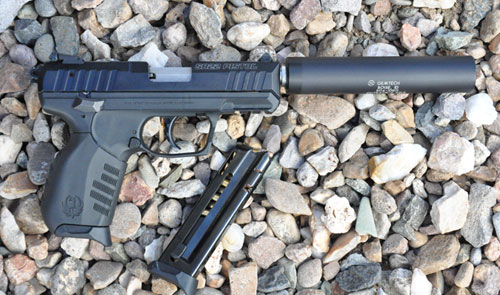
Lastly, it’s easy to personalize. Aftermarket parts like Tandemkross’s captured guide‑rod assembly and +5 “Wingman” mag bumpers are common and inexpensive if you want snappier cycling or more capacity per mag.
Flaws but Not Dealbreakers: The double‑action pull is long and heavy. That’s by design on a compact DA/SA; it makes the gun safe to stage and carry. If you want precision, cock the hammer for a lighter single‑action break. One test of the 4.5 inch version measured SA at 6.4 pounds.
Ten‑round mags are the factory norm. If you want longer strings, the Tandemkross +5 basepads help, but they do extend the magazine and aren’t OEM.
Probably the biggest hangup is that there’s no factory slide cut, so this isn’t the pick if a micro dot is a must. On the flip side, the adjustable irons are better than most in this size. Additionally, the safety lever orientation is “down for safe.” Shooters coming from 1911‑style safeties may need a little retraining since decocking and safe use are done with the lever pushed down.
Note for used‑gun shoppers: Ruger issued a product‑safety retrofit for certain early SR22s that showed slack single‑action or could discharge on decocking. Check your serial and get the free fix if applicable.
Bottom Line: Buy the Ruger SR22 if you want a compact, affordable DA/SA .22 that’s easy to live with and easy to teach on. It’s ideal for decocker practice, low‑recoil fundamentals, and light‑and‑laser training in a small package.
9. BEST BUDGET HIGH‑CAPACITY .22: KelTec P17
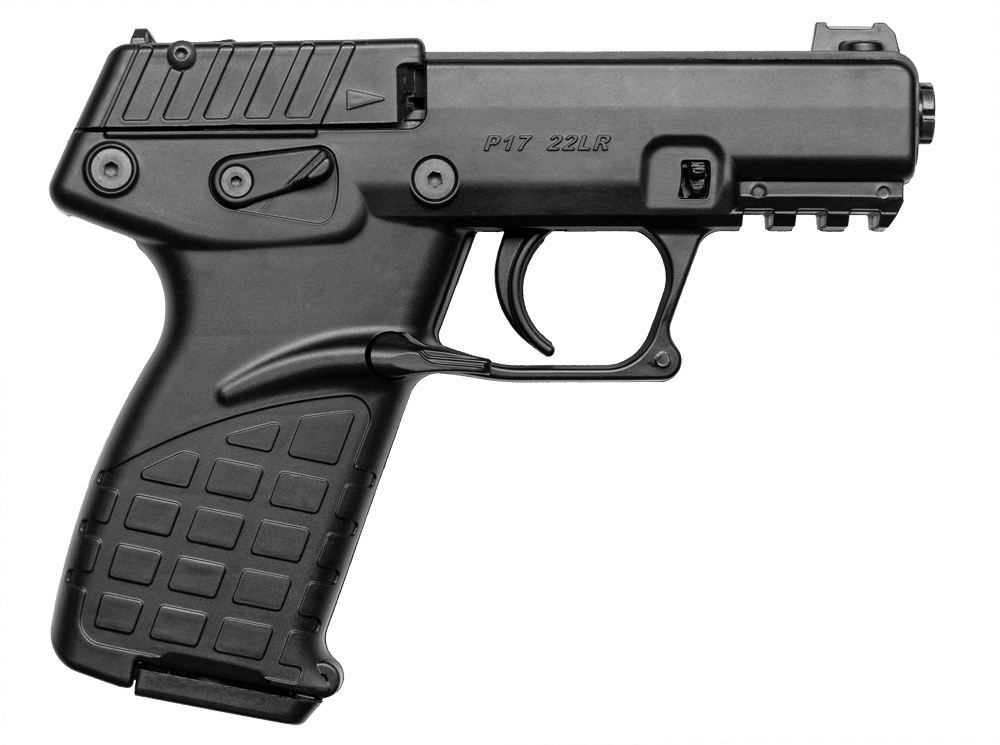
KelTec P17
KyGunCo (See Price)
Cabela’s (See Price)
Primary Arms (See Price)
BattleHawk Armory (See Price)
Classic Firearms (See Price)
Scheels (See Price)
Midway USA (See Price)
Hinterland Outfitters (See Price)
DEGuns (See Price)
There’s budget-friendly and then there’s budget-friendly. This is the latter.
KelTec is known for clever, lightweight designs at working‑man prices, and the P17 is the most budget‑friendly example in its rimfire lineup.
It’s a compact .22 LR with a 16+1 capacity, a threaded barrel, fiber‑optic front and adjustable rear sights, ambidextrous controls and three magazines in the box. MSRP is listed at $220 and big‑box retailers often list it around the $200 mark, which is rare for a pistol with this feature set.
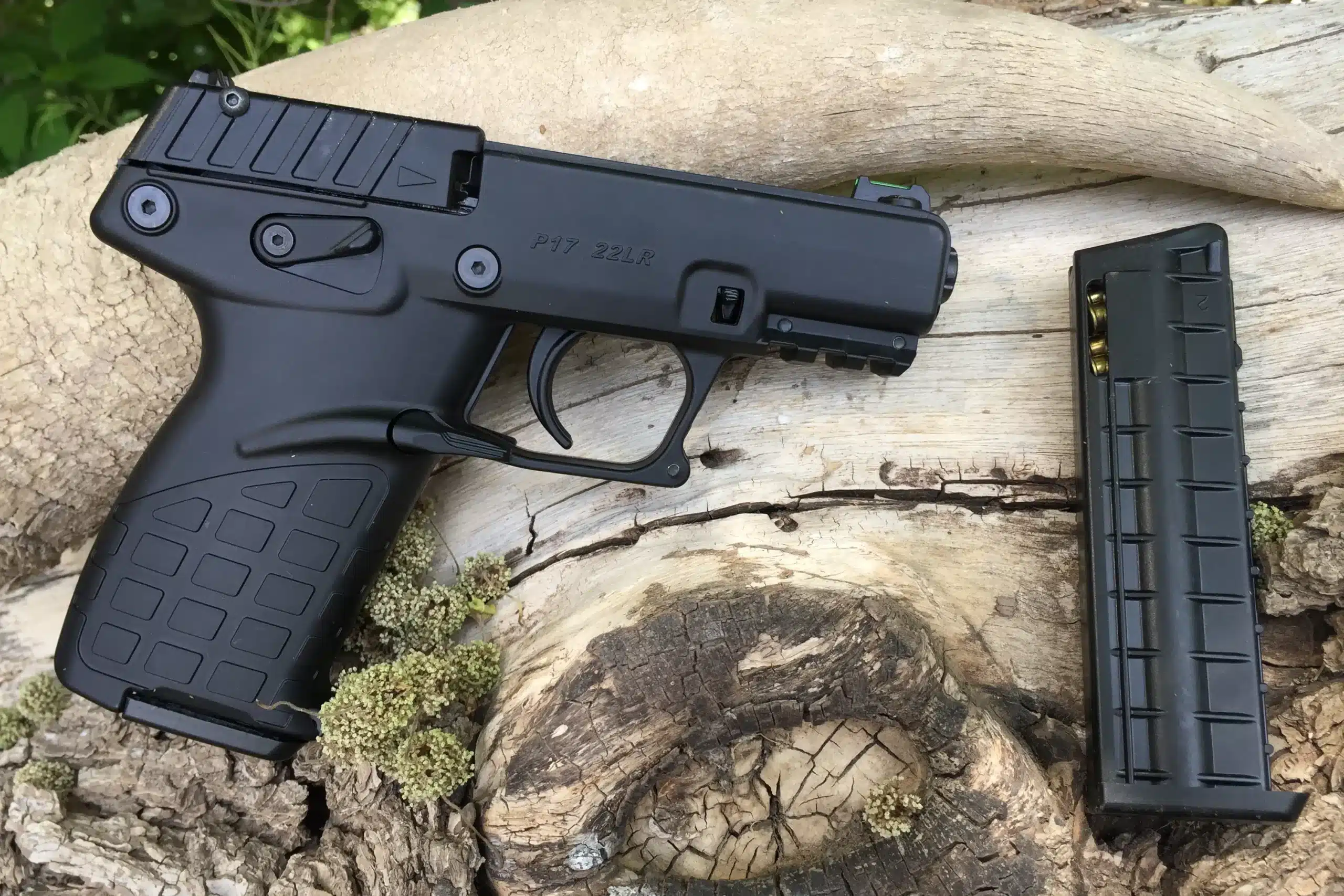
What We Like: The P17 stuffs 16 rounds into each mag and stays under 14 ounces when loaded. Translation: long strings and less fatigue for newer shooters. And yes, those three 16‑round magazines are standard in the box.
For the money, it’s pretty feature-rich. You get a 3.8‑inch barrel threaded 1/2×28, a fiber‑optic front with an adjustable rear, an accessory rail, an ambi safety and an ambi paddle‑style magazine release. Not bad capability for a budget trainer.
KelTec lists the pull at roughly 3 lb on current spec sheets, and the hammer‑fired single‑action system keeps the break light and predictable for calling shots. Additionally, the P17 is suppressor‑friendly out of the gate. The barrel is threaded and KelTec includes the muzzle/adapter hardware so you can spin on a rimfire can without hunting for parts.
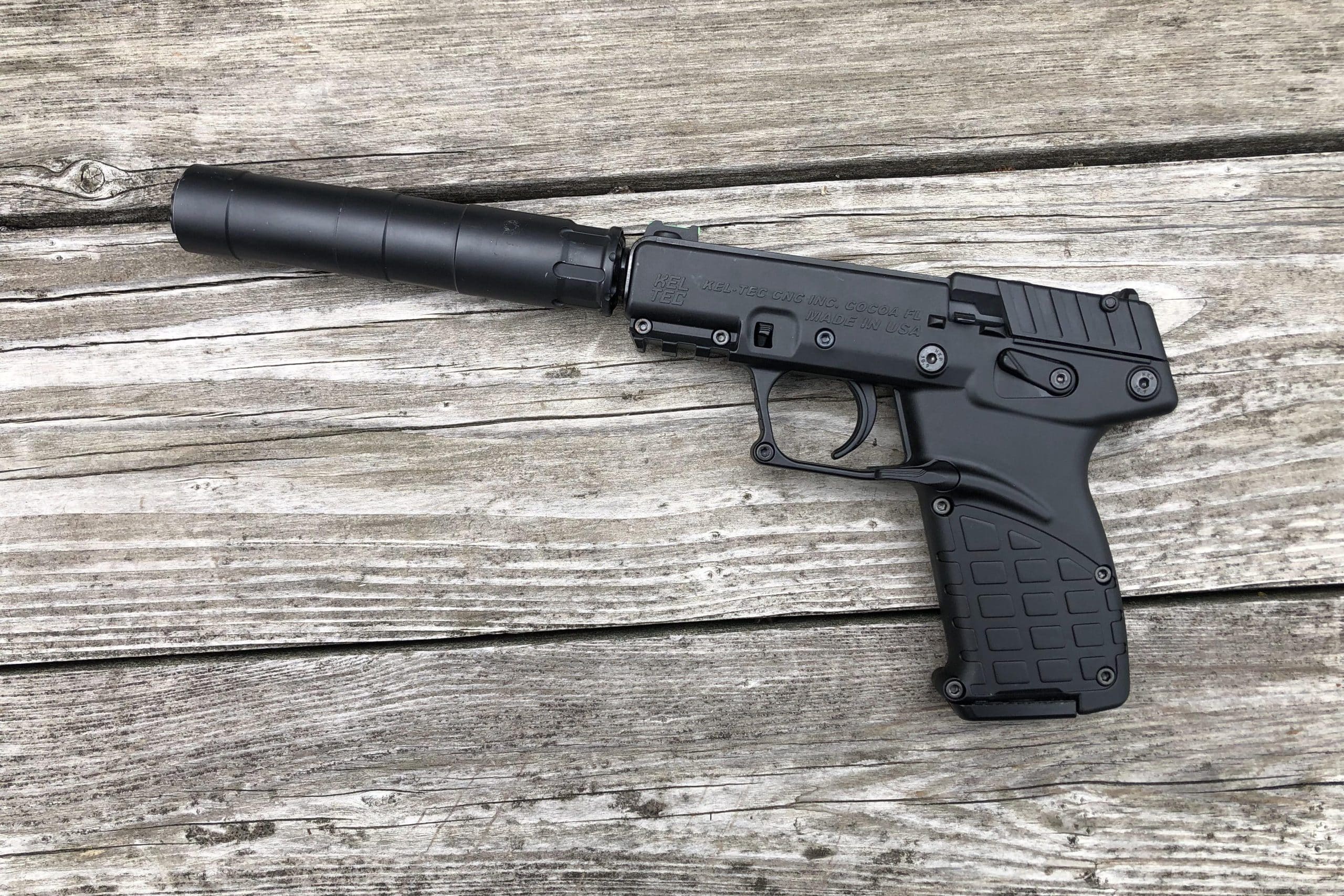
In terms of on-paper accuracy, the results are respectable. Average groups hover around 2.25 inches at 15 yards, with the only hiccups showing up late in the session when a gun cleaning is needed.
Flaws but Not Dealbreakers: The main drawback is that it’s not optics‑ready from the factory. If you want a dot, KelTec sells a complete red‑dot slide assembly. It works, but at about $200 it’s nearly the cost of the gun itself. Most buyers at this price point are fine staying with irons.
Ammo choice matters. The owner’s manual specifies high‑velocity, brass‑cased .22 LR. Standard‑velocity or odd‑shaped bullets can cause cycling issues, which is normal for lightweight blowback .22s. Once you find a load it likes, stick with it.
Additionally, it uses polymer sighting pieces and slide cover. That’s to be expected at this price range. The FO front and rear live in polymer housings and the slide cover is molded nylon. They keep weight and cost down, but heavy users may eventually prefer aftermarket upgrades.
In our experience, the loading technique and controls have quirks. The last couple rounds can be stiff until magazines break in, and the small slide stop isn’t the easiest to use as a release. Neither is a showstopper once you’ve learned the gun.
Bottom Line: If you want maximum reps per dollar in a modern .22 LR pistol, the KelTec P17 is tough to beat. It’s light, simple, genuinely high‑capacity, and ships with the sights, threads and extra magazines that make range time fun and productive. Buy it as a trainer, a plinker, or a starter pistol for new shooters who will benefit from low recoil and easy controls.
10. BEST .22LR DA REVOLVER: Smith & Wesson Model 617
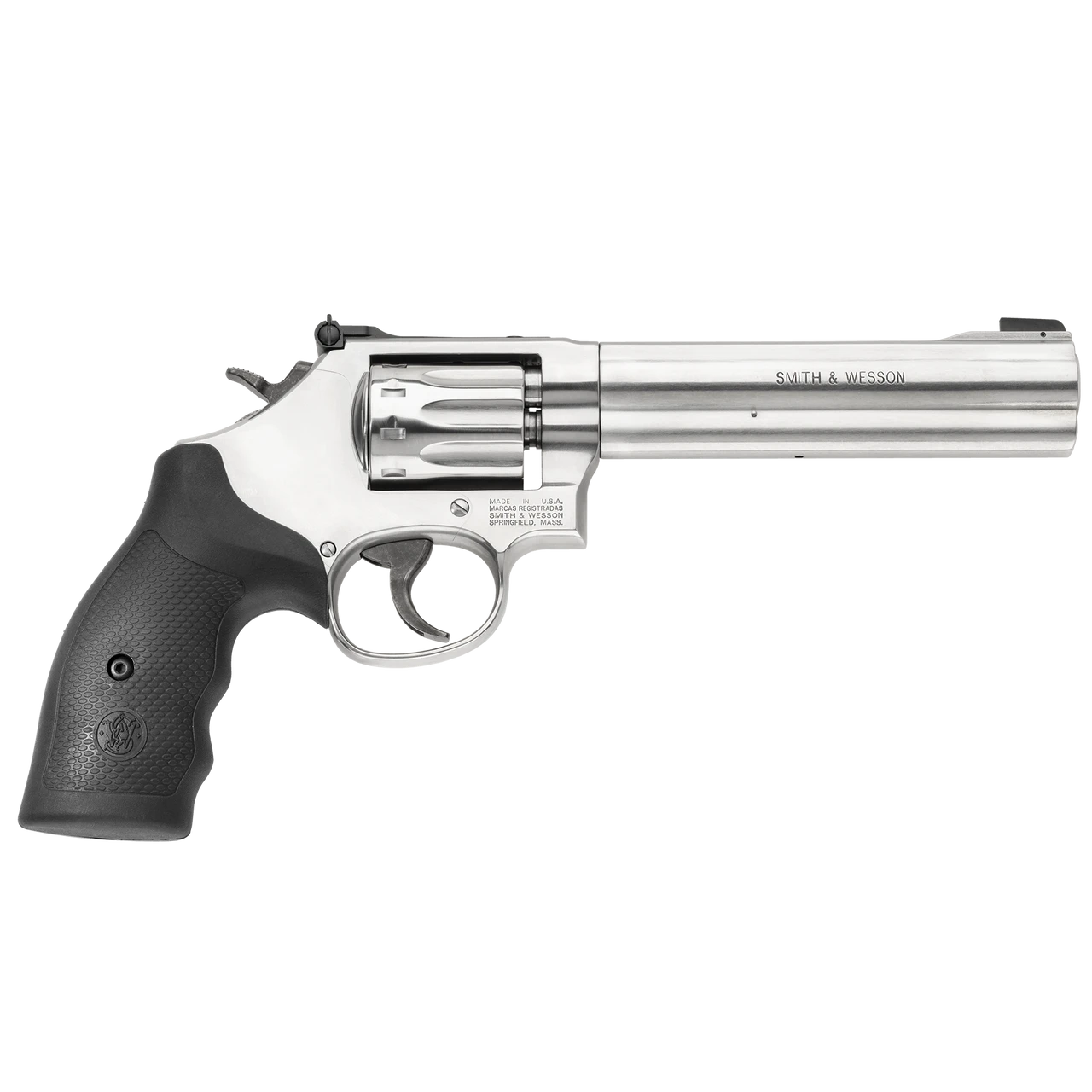
Smith & Wesson Model 617
Palmetto State Armory (See Price)
Brownells (See Price)
Midway USA (See Price)
Scheels (See Price)
Classic Firearms (See Price)
KyGunCo (See Price)
Hinterland Outfitters (See Price)
BattleHawk Armory (See Price)
DEGuns (See Price)
Smith & Wesson’s K‑frame rimfire is a classic formula done in stainless steel. The Model 617 gives you a full‑size, 10‑shot .22 LR revolver with adjustable sights and either a 4 or 6 inch barrel.
It lives at the top of the .22 wheelgun heap because it feels like a real service revolver, not a toy, and it is built to last. Current list pricing on the standard 4 and 6 inch models is shown at 979, with a lighter 617 Mountain Gun variant recently added to the lineup.
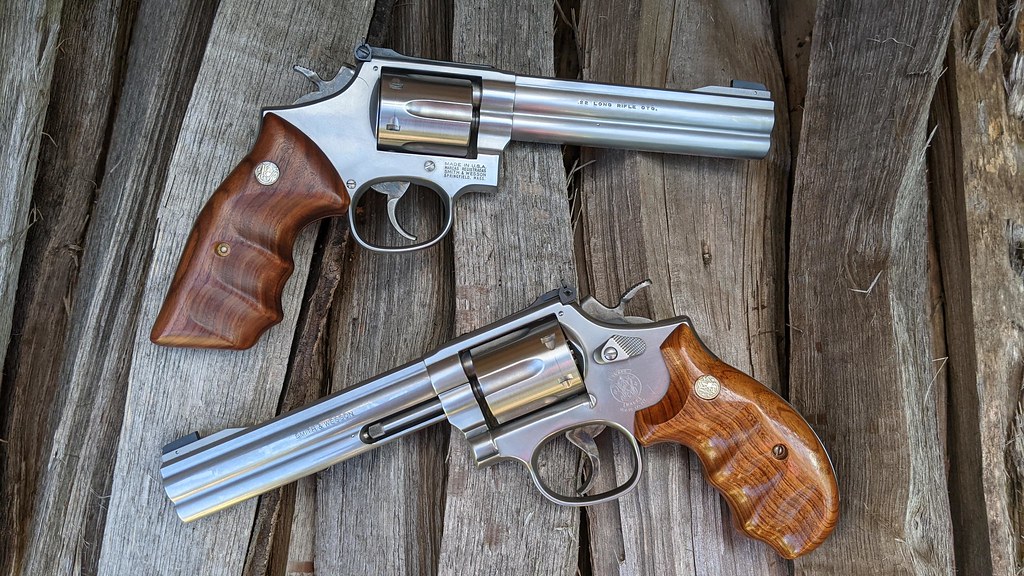
What We Like: Easy translation to centerfire skills. The 617’s size and control layout closely mirror S&W’s medium‑frame .357s, which makes it a terrific understudy for a 686. You get real double‑action reps with rimfire economy. Essentially, the 4 inch 617 an excellent 686 trainer.
The heavy, full underlug barrel and long sight radius help the gun sit still on target. The 6 inch version weighs about 44 ounces, which soaks up movement and makes tiny groups feel routine once your trigger stroke is consistent. So, you get both single‑action and double‑action performance for accuracy practice.
We love that you get ten shots before you reload. That’s not a big deal for the semi-auto counterparts, but a 10‑round cylinder is a big deal on a DA .22 revolver. It keeps steel‑plate strings and drill work moving without constantly topping off.
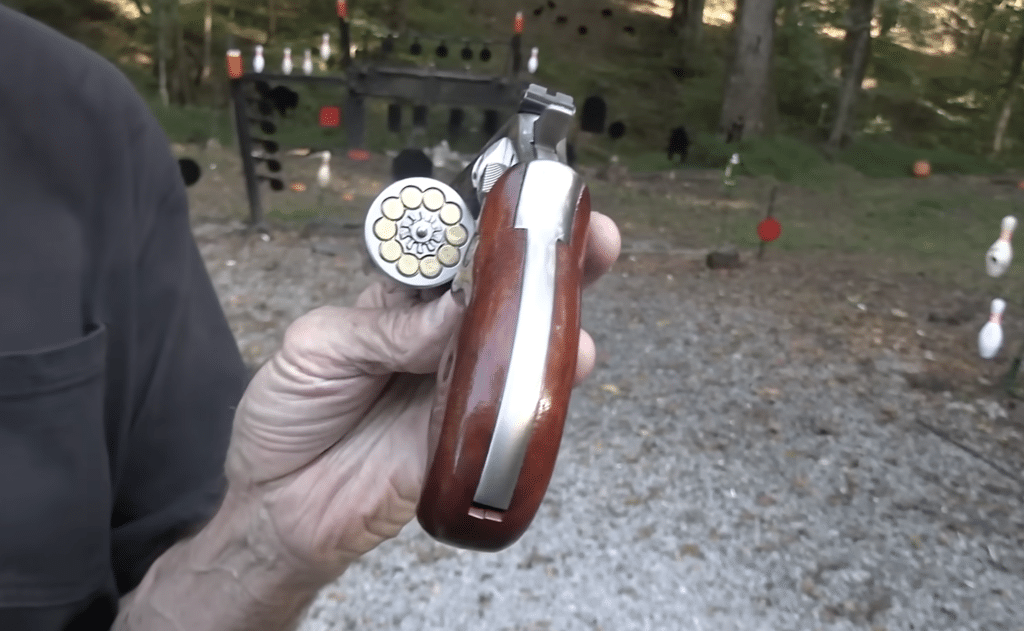
We also like that optics are straightforward to add. Modern K‑frames come drilled and tapped under the rear sight, and purpose‑built plates from EGW or Weigand bolt right on so you can mount a micro red dot or a scope without gunsmithing. It is an easy path to a dot for aging eyes or small‑game hunting.
Lastly, is the joy of holding a real revolver. Stainless frame, cylinder, and barrel with a proper target sight set and full underlug give the 617 that bombproof feel and steady sight picture people buy K‑frames for.
Flaws but Not Dealbreakers: There’s a few drawbacks here. The double‑action pull is on the heavy side. That is common on rimfire revolvers because the mainspring has to hit the rim hard, and DA pulls in the 12 to 15 pound neighborhood are typical. The 617’s DA is usually smooth, and SA is crisp, but if you are used to a tuned centerfire you will notice the weight.
It is a chunk of steel. At roughly 40 ounces for the 4 inch and about 44 ounces for the 6 inch, this is a hefty .22. The upside is a rock‑steady sight picture and almost no muzzle movement, which flatters newer shooters.
What’s more, you will need a plate to mount a dot, and there are no factory threads on the standard barrels. If a can is part of your plan, you are looking at aftermarket barrel work.
Lastly, compared with budget .22 pistols, a new 617 costs real money. Typical dealer price comes in around $920. On the flipside though, you get a lifetime revolver that holds value and doubles as a trainer and small‑game gun.
Bottom Line: Buy the Model 617 if you want a true double‑action .22 that feels like a service revolver, teaches a proper DA trigger, and has the accuracy for steel matches or small‑game duty. Go 4 inch for better balance and general training, or 6 inch if you want maximum sight radius and steadiness.
11. BEST BUDGET SA REVOLVER: Ruger Wrangler Revolver Burnt Bronze .22LR
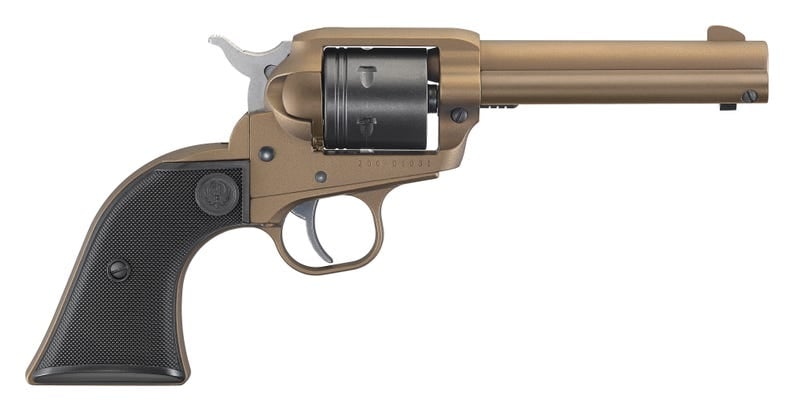
Ruger Wrangler Revolver Burnt Bronze .22LR
Palmetto State Armory (See Price)
Cabela’s (See Price)
KyGunCo (See Price)
Guns.com (See Price)
Classic Firearms (See Price)
Midway USA (See Price)
Scheels (See Price)
Sportsman’s Guide (See Price)
Hinterland Outfitters (See Price)
BattleHawk Armory (See Price)
DEGuns (See Price)
Ruger’s Wrangler brings the single‑action .22 LR back into “anyone can afford it” territory while keeping the feel of the company’s classic Single‑Six.
You get a six‑shot cylinder, fixed sights, transfer‑bar safety, and a durable Cerakote finish in multiple barrel lengths and colors, with street prices that hover around entry‑level .22 pistols. It is a simple, safe plinker that also doubles as an inexpensive way to learn single‑action fundamentals.
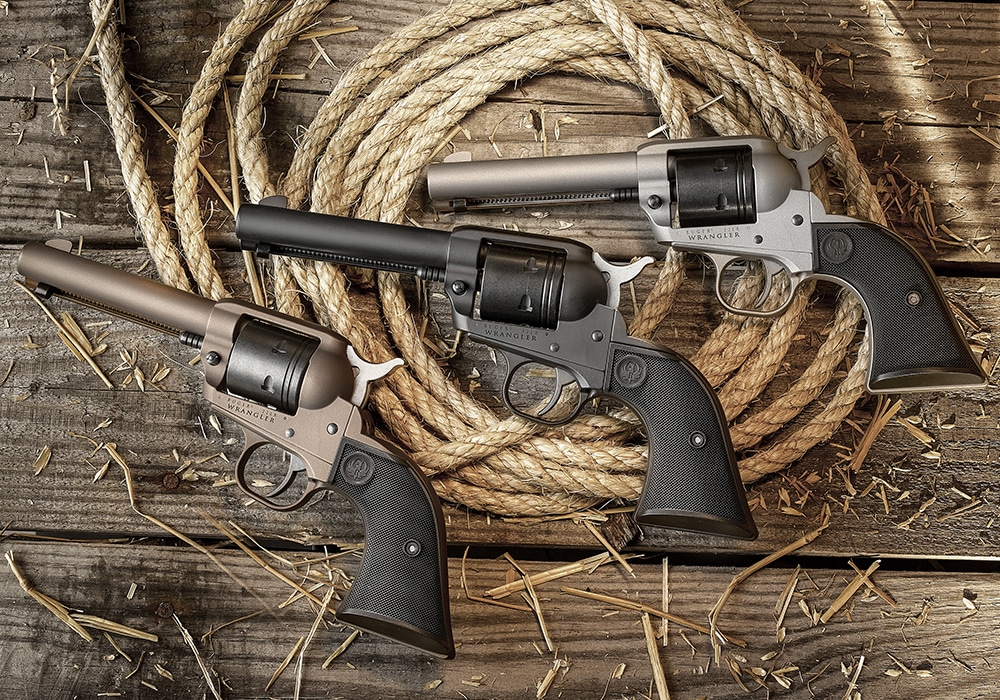
What We Like: You get real Single‑Six DNA without the Single‑Six price. The Wrangler keeps the size and grip of the New Model Single‑Six, so it fits many of the same holsters and accepts the same grip panels. The barrel is cold‑hammer‑forged carbon steel and the gun uses Ruger’s time‑tested transfer‑bar mechanism.
Really, the free‑spin loading is beginner friendly. Open the loading gate and the cylinder turns freely in either direction, which makes lining up chambers for loading and ejection easy. If you learned on fixed‑index sixguns, this feels refreshingly simple.
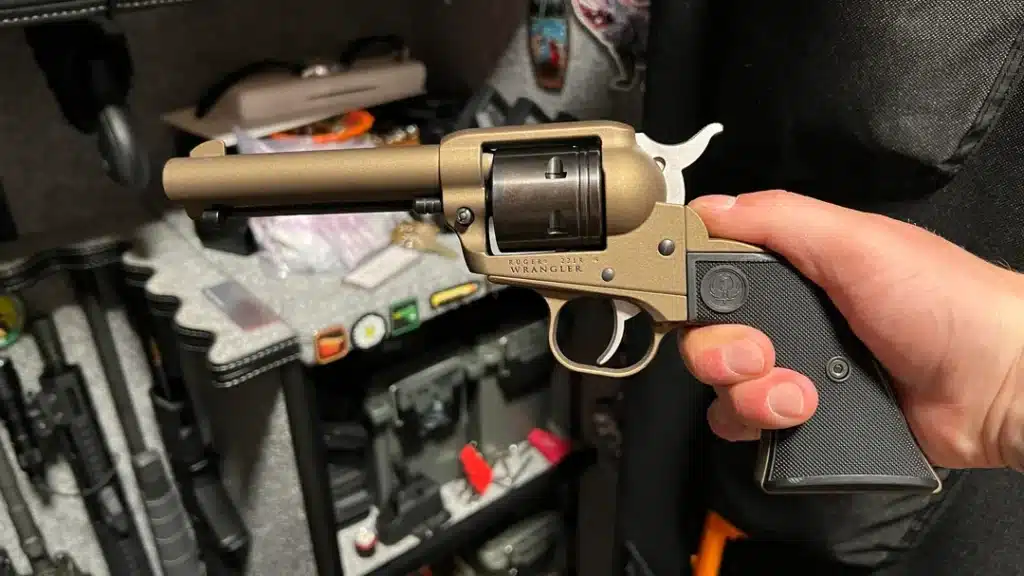
Add to that, Ruger keeps costs down with an aluminum‑alloy frame and zinc‑alloy grip frame under a uniform Cerakote finish. The steel barrel and cylinder handle the wear, while the coating shrugs off scuffs and weather.
Something else that stood out to me is that unlike old‑style single‑actions, the transfer bar keeps the firing pin blocked unless the trigger is pressed, so you are not forced to keep an empty chamber under the hammer. You’re safe to carry six.
It has surprisingly shootable accuracy. We produced roughly 3‑inch five‑shot groups at 25 yards with bulk .22, and trigger pulls around four‑and‑a‑half pounds, which is solid for fixed sights and plinking ammo.
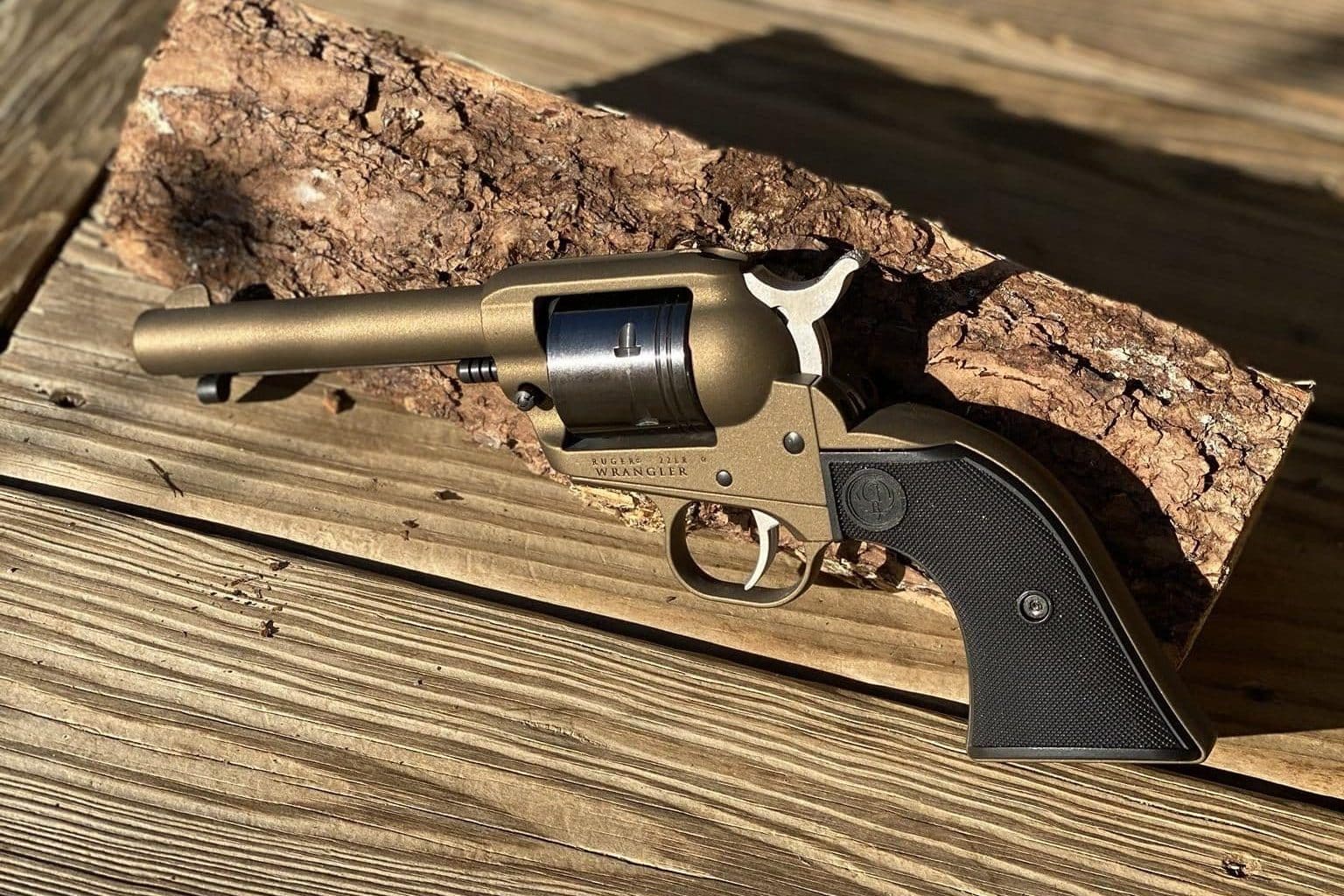
Lastly thing to note is the price. There’s a plethora of options on SKU and finish, but these typically come in around $200. It’s a true budget SA revolver.
Flaws but Not Dealbreakers: Fixed sights mean limited adjustability. The Wrangler wears a blade front and integral rear notch, so you correct windage and elevation mainly with ammo choice and hold. Many owners simply paint the front sight for visibility. If you want click‑adjustable sights, Ruger’s Super Wrangler costs a bit more and adds an adjustable rear and a .22 WMR cylinder.
The finish and parts are utilitarian. Expect visible mold lines on the grip frame and polymer stocks out of the box. Function is the priority at this price, and the samples we tested still ran smoothly.
Controls can be a tad stiff when new. You’ll get a firm loading gate and hammer at first. They tend to smooth out with a little use and lubrication.
Lastly, it’s not optics‑ready. There is no provision for a scope base or red dot, which fits the old‑school brief. If you know you will want a dot, you will be happier with a different platform.
Bottom Line: Buy the Ruger Wrangler if you want a simple, safe, and inexpensive single‑action .22 that lets you shoot a lot and smile the whole time. It is ideal for plinking, teaching new shooters, and getting that classic six‑gun feel without paying classic six‑gun money. If adjustable sights or optics are must‑haves, look at the Super Wrangler or a Single‑Six.
12. BEST ULTRA‑EASY‑TO‑RACK .22 AUTO: Ruger Lite Rack LCP II
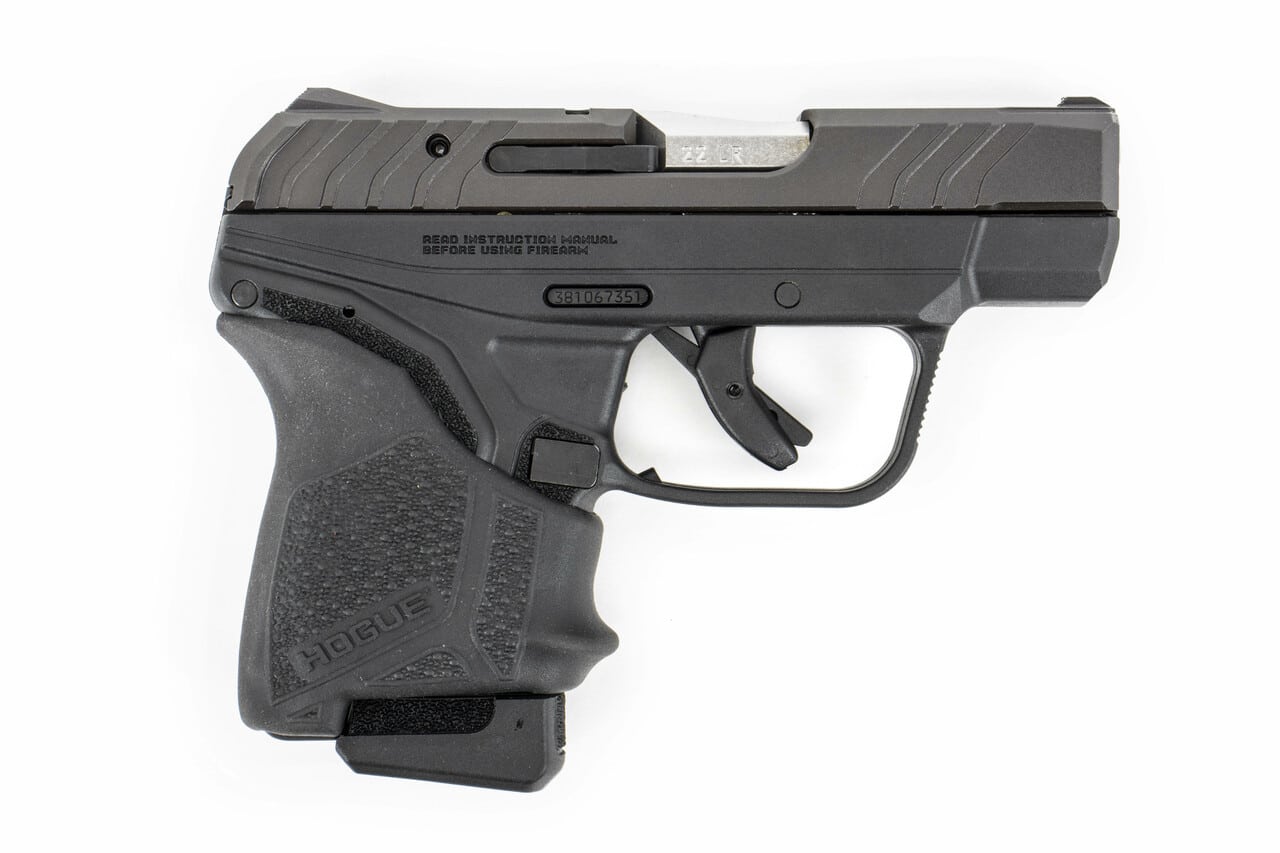
Ruger Lite Rack LCP II
Cabela’s (See Price)
Scheels (See Price)
Classic Firearms (See Price)
Midway USA (See Price)
KyGunCo (See Price)
Primary Arms (See Price)
Hinterland Outfitters (See Price)
BattleHawk Armory (See Price)
Ruger introduced the Lite Rack LCP II to be the pocket‑size .22 that almost anyone can run. The slide uses lighter springs, deeper serrations, and little cocking ears so it is genuinely easy to rack.
Pair that with a 10+1 capacity, last‑round hold‑open, and a simple manual safety, and you get a low‑recoil trainer or kit gun that is far friendlier to small hands or reduced hand strength than most tiny pistols. Street price runs between $340-$370.
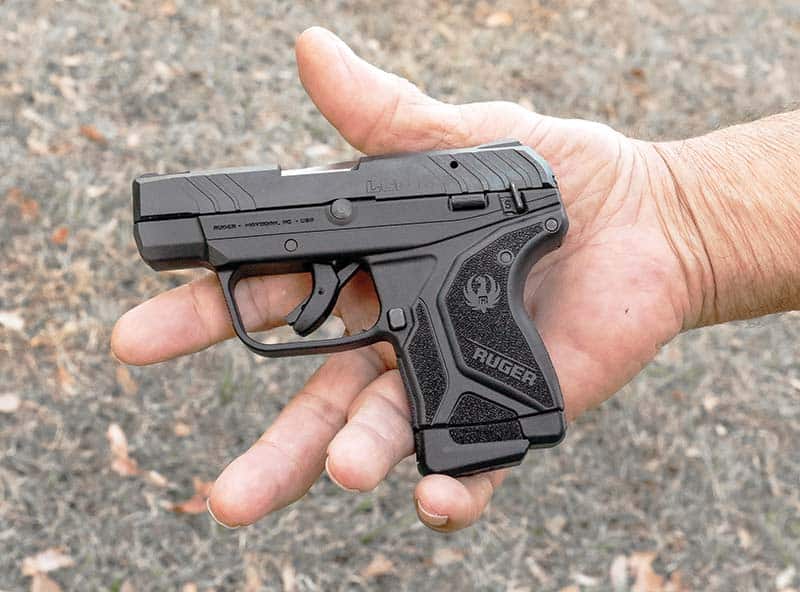
What We Like: Slide effort is truly light. Ruger’s Lite Rack system combines a lighter recoil spring with refined serrations and cocking ears, so chambering a round or clearing the gun takes noticeably less effort than typical micro autos.
With the LCP II you get some great features in a featherweight package. You still get a proper slide stop that locks open on empty, a manual safety, and a 10‑round magazine in a pistol that is 5.20 inches long and about 11.2 ounces. That makes range handling and teaching much easier than with tip‑ups or tiny blowbacks.
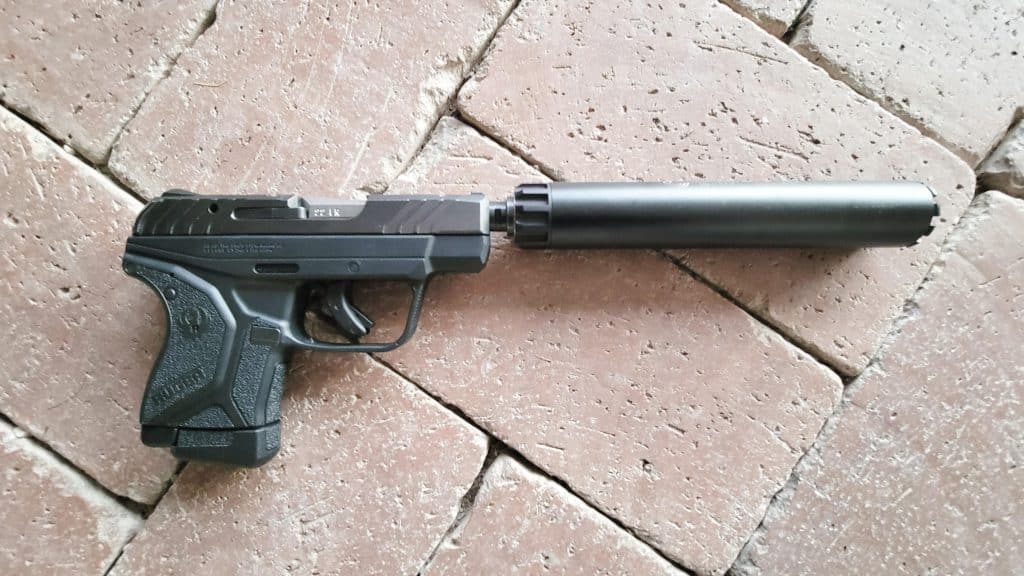
You can get a lot of high‑volume practice with this pistol as well. The .22 LR chambering is optimized for high‑velocity ammo, the felt recoil is minimal, and Ruger even includes a magazine loader in the box to save your thumbs. Lord knows I need it.
Dry‑fire is friendly as long as a magazine is inserted.
Another positive is if you decide later to run a rimfire can, Ruger sells a drop‑in threaded‑barrel kit with a 1/2×28 adapter and the tools you need. No gunsmithing required.
Flaws but Not Dealbreakers: The integral sights work and stay put, but they are small and low‑contrast. A lot of users simply paint the front blade or add a dot of nail polish to help it pop.
A big drawback is that it’s not optics or rail‑ready. There is no factory optics cut and no accessory rail. If a red dot or light is non‑negotiable, you will want a different platform.
Lastly, the short sight radius limits precision. With a 2.80 inch barrel and micro dimensions, this is not a bullseye pistol. It shines at close‑range fundamentals and confidence building, not 25‑yard groups.
Bottom Line: Bottom Line
Buy the Ruger Lite Rack LCP II if you want the easiest‑to‑rack .22 auto you can slip in a pocket or use as a low‑recoil trainer. It is ideal for new shooters, anyone with reduced hand strength, or experienced shooters who want cheap reps with real controls and a last‑round hold‑open.
FINAL THOUGHTS ON THE BEST .22LR PISTOLS
A good .22LR pistol is like a good training partner. You barely notice it when it is doing its job, but you will absolutely notice when it is not. The right rimfire makes practice feel productive, not wasteful. The wrong one turns range time into a string of stoppages, missed zeros, and excuses.
If you want a do-it-all trainer that tolerates optics and suppressors, the Ruger Mark IV 22/45 Tactical and the FN 502 Tactical are both excellent places to start.
If classic target feel and match accuracy are what you chase, the Browning Buck Mark Field Target SR and the S&W Model 617 will make you smile at a paper target.
For high-capacity, optics-ready practice that feels modern, the SIG P322 and Taurus TX22 TORO give you lots of reps without breaking the bank. If you live in the Glock world and want direct skill transfer, the Glock 44 is the obvious pick.
For pure value and volume, the KelTec P17 and Ruger Wrangler get more rounds on target for less cash.
None of these are perfect for every shooter. A picky ammo eater that runs like a champ on one brand can be a nightmare on another. A pistol with a great trigger out of the box might cost you when you add an optic. Think about what you want most: fidelity to your carry gun, the quiet of a suppressed setup, cheap volume practice, or match-grade groups. Buy for purpose, not for hype.
Got a favorite .22 that didn’t make the list or a load that your pistol absolutely loves? Drop a comment below and tell us what you run and why. I read every recommendation and I want to know which rimfire turned your range days from meh to meaningful.

Justin Trump is the managing editor and owner of CAT Outdoors. The son of a Vietnam veteran, he’s a Certified Glock Armorer, an avid gun enthusiast and 2A advocate. He holds two firearm patents for the CAT M4 and Talon tools. When not managing CAT Outdoors, he enjoys spending time with his family and friends, rooting for Michigan sports teams, and serving his church.

